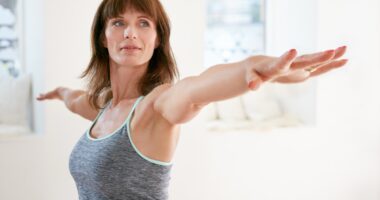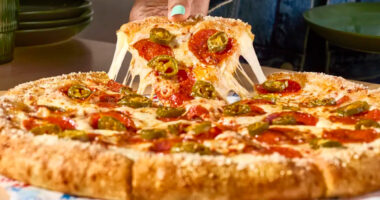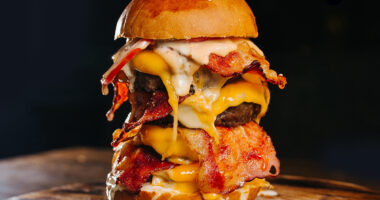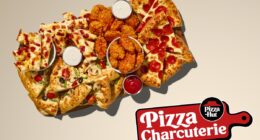Health experts have long touted the nutritional benefits of fish: These sea creatures rank high on lists of the best sources of heart-healthy omega-3 fatty acids, high-quality protein, metabolism-friendly selenium, energy-boosting Vitamin B12, and inflammation-fighting Vitamin D. But even though eating fish is highly recommended, choosing which best fish to eat can be more difficult than navigating a rowboat in a stormy sea.
When you buy fish, it can be tricky to balance your healthy eating ambitions with your concerns about your heart health and mercury levels—not to mention sustainable fishing practices or ocean health. Omega-3s are essential nutrients that help ward off heart disease, diabetes, and metabolism-slowing inflammation, and they’re primarily found in fish. Unfortunately, another element primarily found in fish is mercury.
Human exposure to mercury is mostly through seafood consumption, and this exposure has been found to cause adverse neurodevelopmental, cardiovascular, and immunological health effects in sufficient doses, according to a report in Journal of Preventive Medicine and Public Health. The FDA considers that the 1,000 parts per billion (ppb) limit provides an adequate margin of safety for adult men and women, and environmental advocacy groups like the Natural Resources Defense Council (NRDC) recommend pregnant women or women planning to become pregnant should avoid eating fish highest in mercury at 500 ppb and over.
To determine the best fish, we compiled a list of popular seafood consumed in the U.S., and we left off endangered species like Atlantic bluefin tuna. Because essential omega-3s and lean protein are two of the most uniquely valuable nutrients provided by fish, we chose to rank the seafood based on these nutritional benefits over standard methods of calories or fat. We also used nutritional perks like selenium, vitamin B12, and vitamin D to break any ties. Using the USDA Nutrient Database, we calculated the omega-3 (DHA and EPA) and protein content of each raw fish for a standard size of 3 ounces. The rankings also factored in potentially toxic levels of mercury from the Environmental Defense Fund‘s Seafood Hg (mercury) Database in ppb as well as the fish’s source—whether wild or farmed using questionable techniques. Read on to find out which fish are keepers and which you should throw back.
(Plus, don’t miss The #1 Best Juice to Drink Every Day, Says Science.)


These fish all ranked in the bottom half of the pack regarding their amounts of omega- 3‘s, protein, and average mercury levels. High mercury levels (above 800 ppb) sent fish to the bottom of the net, as well as fish that had lower than 100 mg of omega-3s. Translation: Shrimp isn’t super awful for you, but it’s ranked poorly because it doesn’t have a whole lot going on in terms of nutrition, either. And sure, swordfish has a lot of protein, but it’s like drinking mercury. Farmed fish also found a place on the worst list, as they’re typically fed an unnatural diet that may include animal products, soy, and dyes.


Nutrition (per 3 oz serving): 118 calories, 5.4 g fat (1.6 g saturated fat), 50 mg sodium, 0 g carbs, 0 g fiber, 0 g sugar, 16.4 g protein
Protein (g per 3 oz): 16.4
Omega-3s (mg per 3 oz): 1,140
Mercury levels (parts per billion): 440
The Spanish Mackerel is essentially the “best of the worst” because what it lacks in the mercury safety department, it (almost) makes up for in omega-3s. With four and half times your minimum recommended daily intake, this fish is sure to help fight heart disease and inflammation. To be safe, the NRDC recommends you limit eating this fish to three servings or less per month.
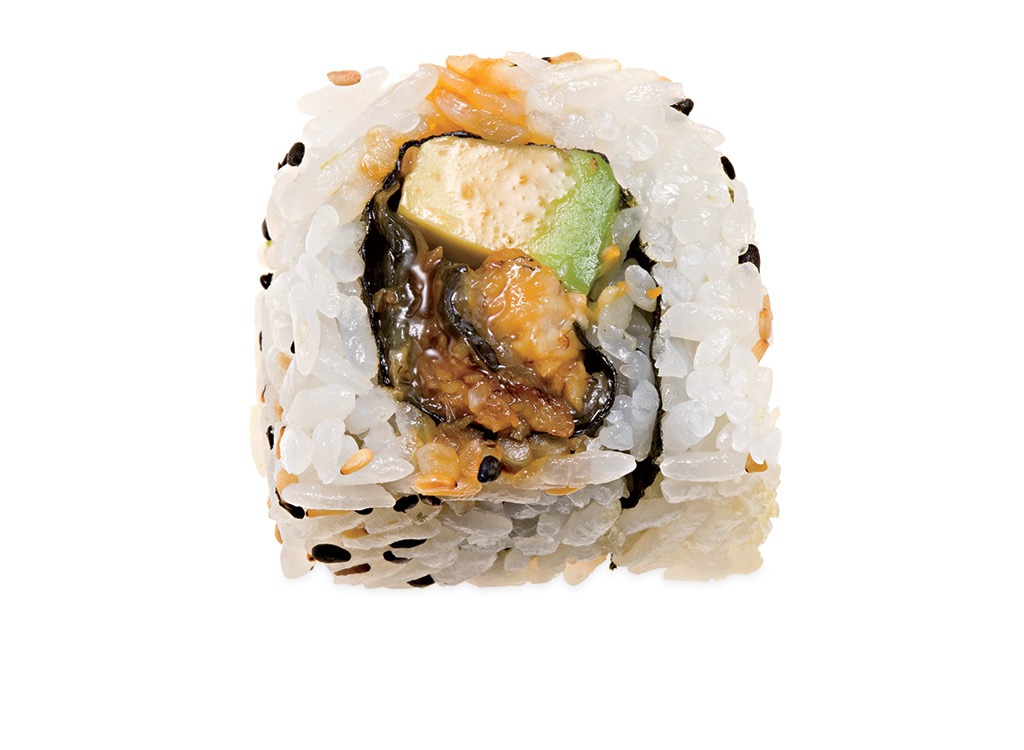

Nutrition (per 3 oz serving): 156 calories, 9.9 g fat (2 g saturated fat), 43 mg sodium, 0 g carbs, 0 g fiber, 0 g sugar, 15.7 g protein
Protein (g per 3 oz): 15.7
Omega-3s (mg per 3 oz): 125
Mercury levels (parts per billion): 186
While this might be your favorite roll at sushi restaurants, Japanese freshwater unagi was listed on Japan’s “red list” of endangered species in 2013 after finding a 70 to 90 percent rate of decline over its last three generations. On the other hand, the American eel population remains stable and has not warranted Endangered Species Act (ESA) preservation. So, buy local if you want to reap its protein-rich benefits.
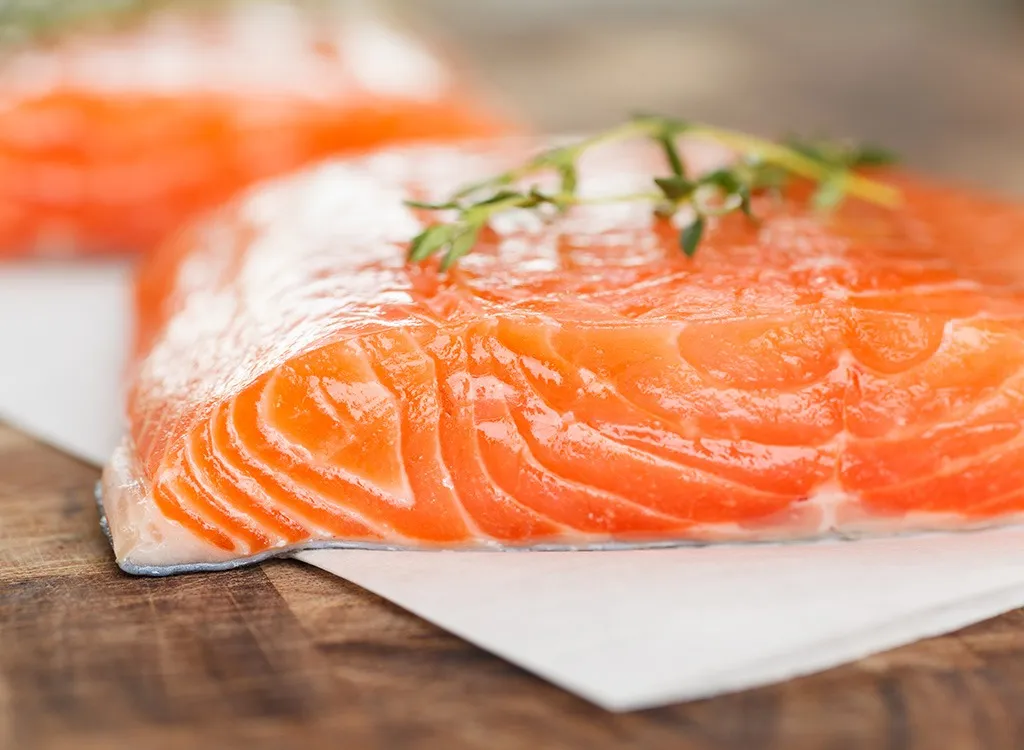

Nutrition (per 3 oz serving): 177 calories, 11.41 g fat (2.6 g saturated fat), 50 mg sodium, 0 g carbs, 0 g fiber, 0 g sugar, 17.4 g protein
Protein (g per 3 oz): 17.4
Omega-3s (mg per 3 oz): 1,671
Mercury levels (parts per billion): 26
Those high levels of omega-3s come with a cost: Soy-fed, farm-raised salmon (99 percent of Atlantic salmon is now farm-raised due to overfishing and pollution) is also packed with around 1,900 mg omega-6s, which actually increase the inflammation omega-3s combat. Also: Farmed salmon are usually dyed pink, have been found to be high in PCBs, and have only one-fourth the belly-flattening vitamin D of their wild cousins.


Nutrition (per 3 oz serving): 81 calories, 2.4 g fat (0.6 g saturated fat), 37 mg sodium, 0 g carbs, 0 g fiber, 0 g sugar, 13.9 g protein
Protein (g per 3 oz): 13.9
Omega-3s (mg per 3 oz): 309
Mercury levels (parts per billion): 144
They might fulfill your daily minimum omega-3 requirement, but catfish are not that clean. Because catfish are bottom feeders who swim in shallow, muddy river water, they are typically exposed to toxins like man-made polychlorinated biphenyls (PCBs) that have been found to influence cognitive deficiencies in exposed infants as well as affect hormone metabolism in adults.
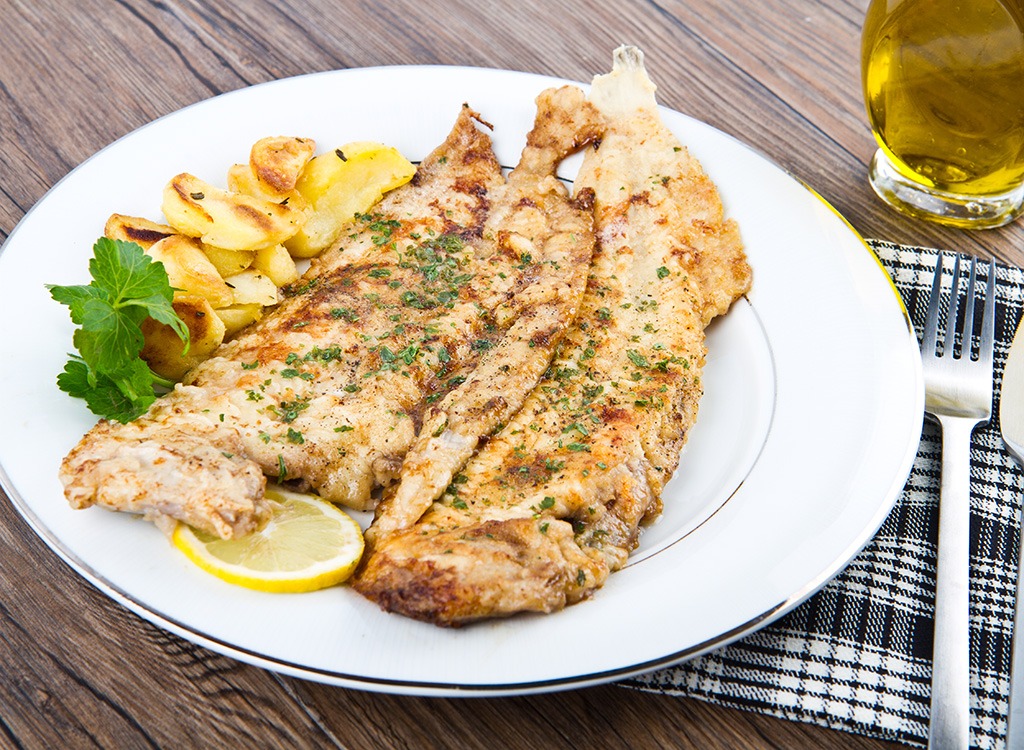

Nutrition (per 3 oz serving): 60 calories, 1.6 g fat (0.4 g saturated fat), 252 mg sodium, 0 g carbs, 0 g fiber, 0 g sugar, 10.6 g protein
Protein (g per 3 oz): 10.6
Omega-3s (mg per 3 oz): 208
Mercury levels (parts per billion): 115
These funny-looking, single-sided flatfish rank low on the omega-3 and protein front, most likely because they’re fairly thin. Since the industrial revolution, world fish stocks of these flatfish has decreased to 10 percent of their original levels, which is a reason to award them a spot on Seafood Watch‘s list of seafood that sustainability-minded consumers should avoid.
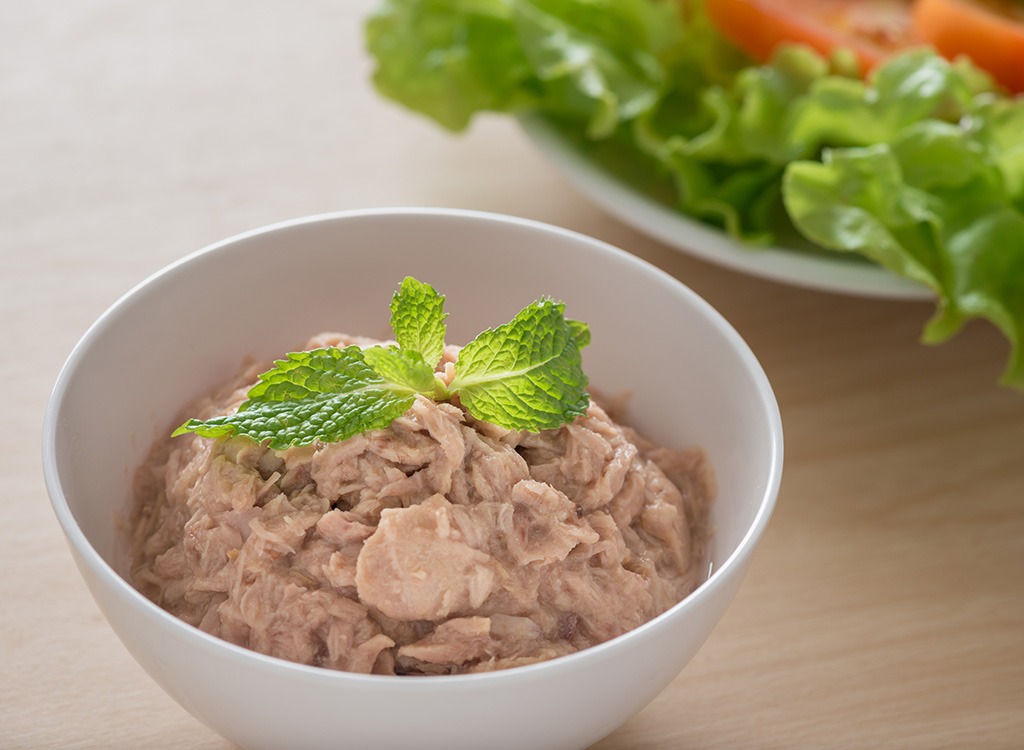

Nutrition (per 3 oz serving): 73 calories, 0.8 g fat (0.2 g saturated fat), 210 mg sodium, 0 g carbs, 0 g fiber, 0 g sugar, 16.5 g protein
Protein (g per 3 oz): 16.5
Omega-3s (mg per 3 oz): 191
Mercury levels (parts per billion): 118
Canned tuna is a pantry staple because it’s a quick, cheap source of protein and rich in vitamins and minerals. It’s also a prime source of one of the two active omega-3 fatty acids: docosahexaenoic acid (DHA). A study in the Journal of Lipid Research showed that omega-3 fatty acid supplementation had the profound ability to turn off abdominal fat genes. DHA, specifically, can be 40 to 70 percent more effective than it’s sister omega-3, EPA, at down-regulating fat genes in the abdomen, which can prevent belly fat cells from expanding in size. But what about the mercury? Just make sure it’s light; canned albacore tuna can have almost triple the levels of mercury. Light tuna is a smaller fish than albacore, which is why it’s considered a “low mercury fish” and can–and should!–be enjoyed two to three times a week (or up to 12 ounces), according to the FDA’s most recent guidelines.
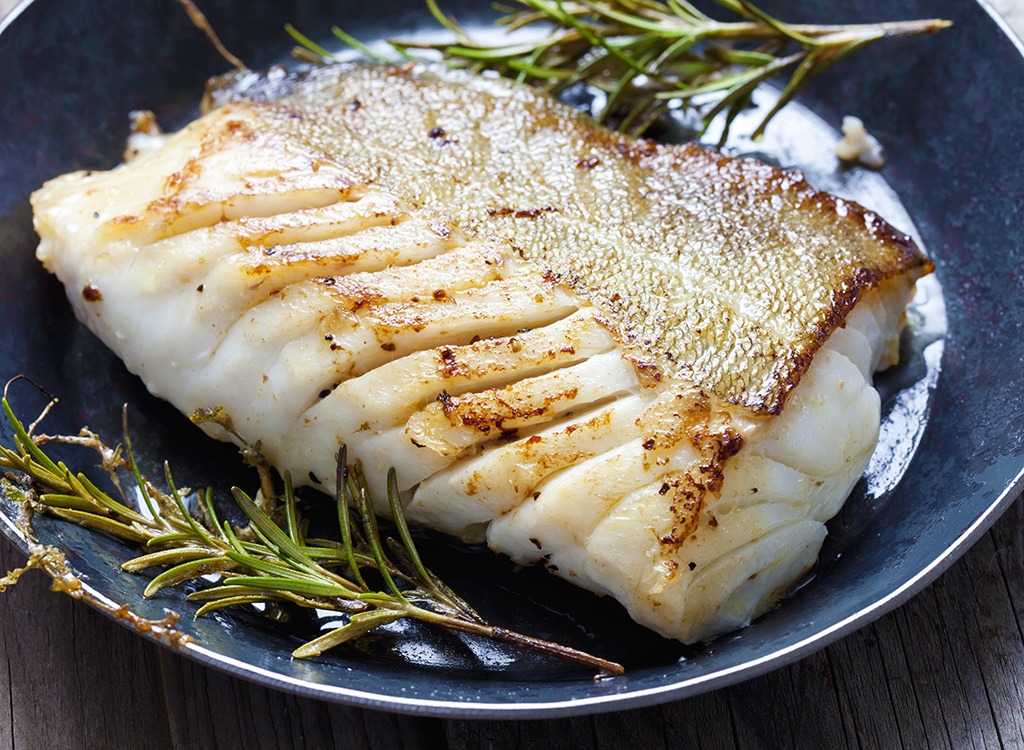

Nutrition (per 3 oz serving): 70 calories, 0.6 g fat (0.1 g saturated fat), 125 mg sodium, 0 g carbs, 0 g fiber, 0 g sugar, 15.1 g protein
Protein (g per 3 oz): 15.1
Omega-3s (mg per 3 oz): 156
Mercury levels (parts per billion): 70
While you won’t be boosting immunity with this fish, research does suggest a regular serving of Atlantic cod may help you stay trim. An eight-week study of 120 men published in Nutrition, Metabolism & Cardiovascular Diseases found that when combined with a calorie-restricted diet, participants who consumed cod five times a week lost more weight and visceral fat and showed better improvements in their blood pressure than those who ate cod just one or three times per week.
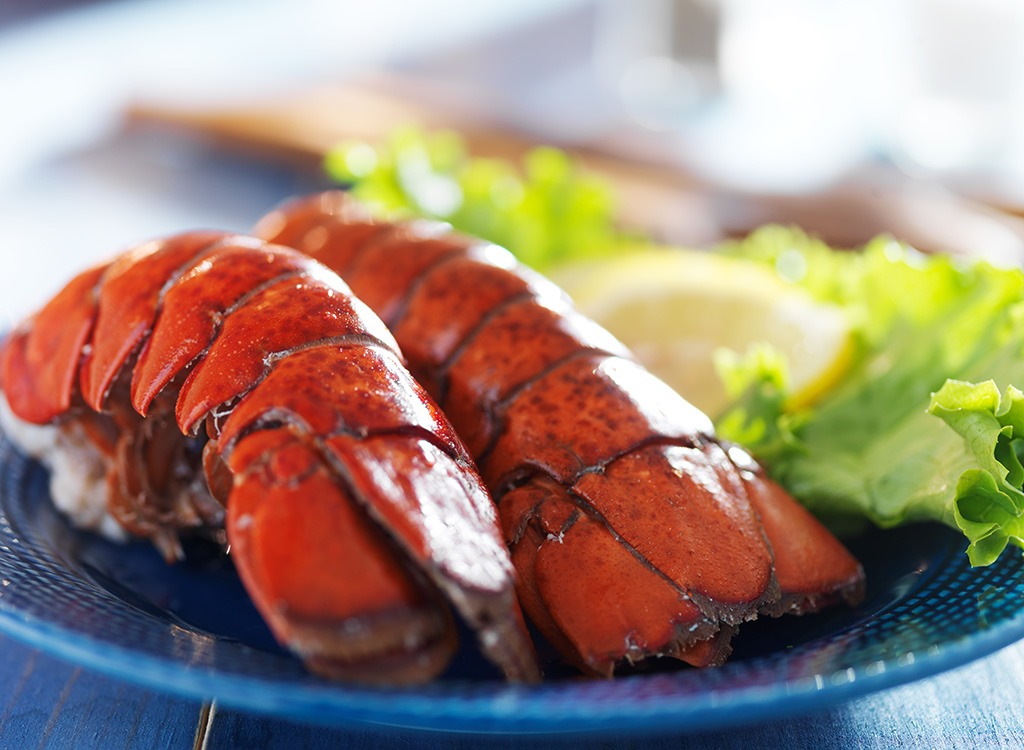

Nutrition (per 3 oz serving): 65 calories, 0.6 g fat (0.2 g saturated fat), 360 mg sodium, 0 g carbs, 0 g fiber, 0 g sugar, 14 g protein
Protein (g per 3 oz): 14
Omega-3s (mg per 3 oz): 145
Mercury levels (parts per billion): 200
A staple of any trip to Maine, this northern lobster has a surprisingly low omega-3 concentration but maintains solid protein levels. You’ll have to eat double the amount of this lobster to get the same omega-3 levels as its spiny cousin (more on that later). Craving this seafood specialty? It’s one of meals under 500 calories at Red Lobster.
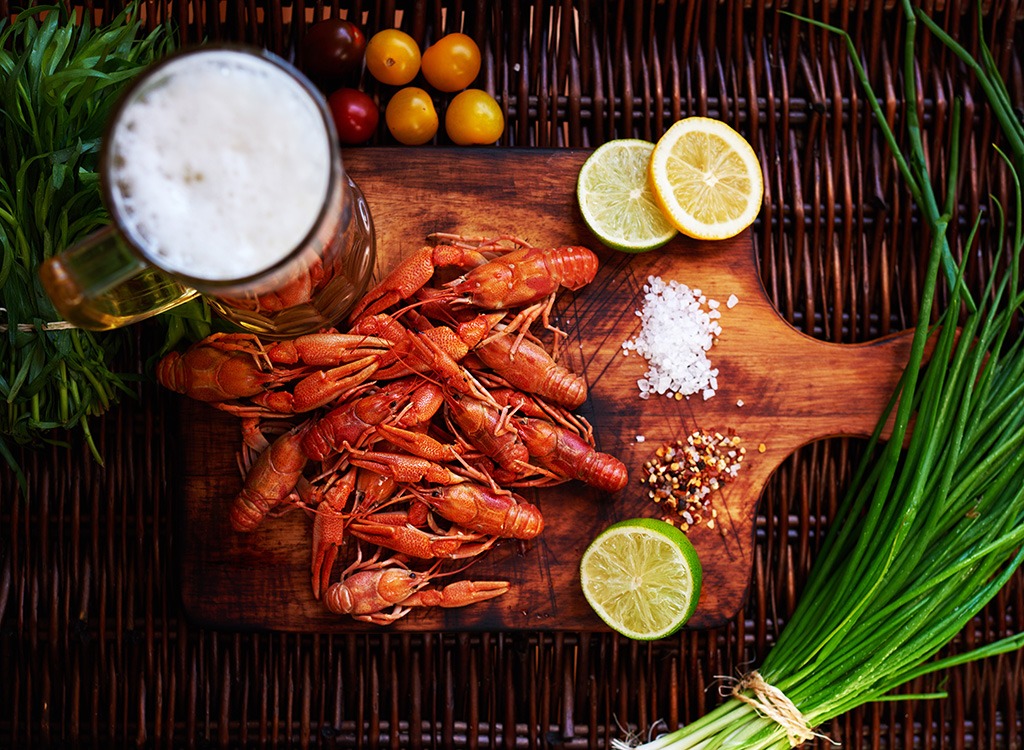

Nutrition (per 3 oz): 61 calories, 0.8 g fat (0.1 g saturated fat), 53 mg sodium, 0 g carbs, 0 g fiber, 0 g sugar, 12.6 g protein
Protein (g per 3 oz): 12.6
Omega-3s (mg per 3 oz): 122
Mercury levels (parts per billion): 34
Known as crawfish, crayfish, and crawdads, whatever you choose to call them, these little crustaceans look and taste a lot like little lobsters. Typically used in Creole cooking down in Cajun country, crawfish festivals have been known to pile the little shellfish by the bucketful. As of 2005, Louisiana supplies 95 percent of the crayfish harvested in the United States from aquaculture. They’re farmed sustainably in rotation with crops and feed on plant material that grows naturally in the pond. The only problem? You have to eat 25 of them to get the nutrition levels listed above.
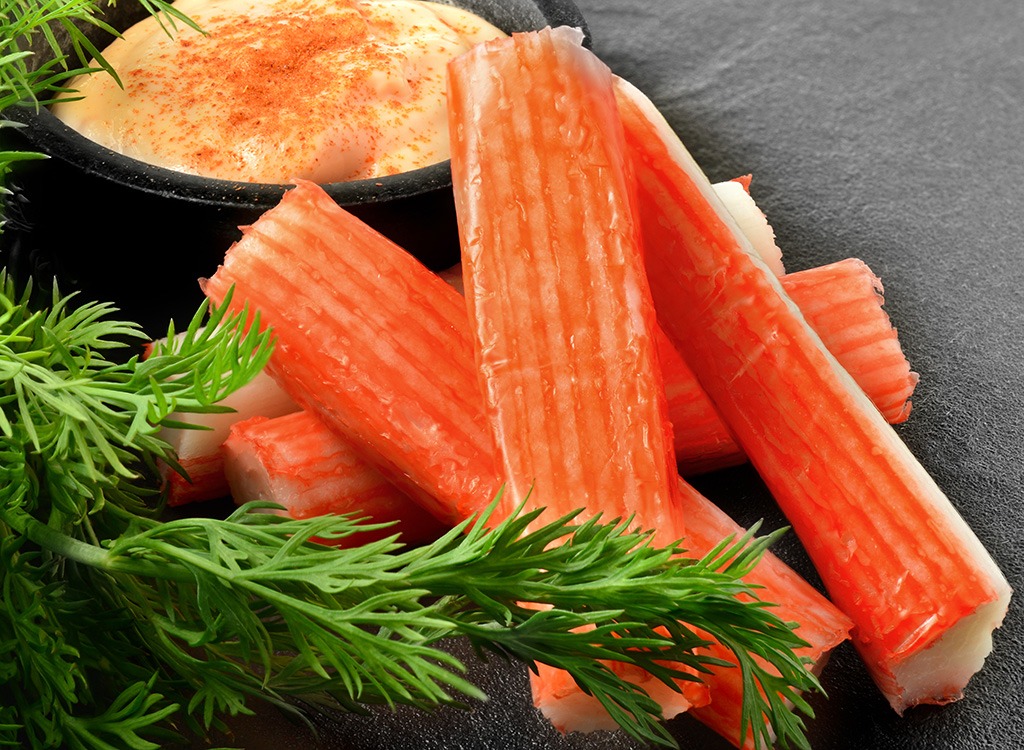

Nutrition (per 3 oz serving): 48 calories, 0.4 g fat (0.1 g saturated fat), 283 mg sodium, 0 g carbs, 0 g fiber, 0 g sugar, 10.4 g protein
Protein (g per 3 oz): 10.4
Omega-3s (mg per 3 oz): 141
Mercury levels (parts per billion): 50
Don’t confuse this fish with cod. Although the pollock is closely related to the Atlantic cod, it lives in the colder waters in the Alaskan North Pacific sea. Furthermore, the FDA just announced that that “Alaska pollock” can only be from Alaska. It might seem trivial, but this label ensures that Alaska will secure its grasp on the pollock market, kicking out its Russian competitors. Why all the competition? Pollock is the largest fishery in the U.S. and accounts for 11 percent of U.S. seafood intake.
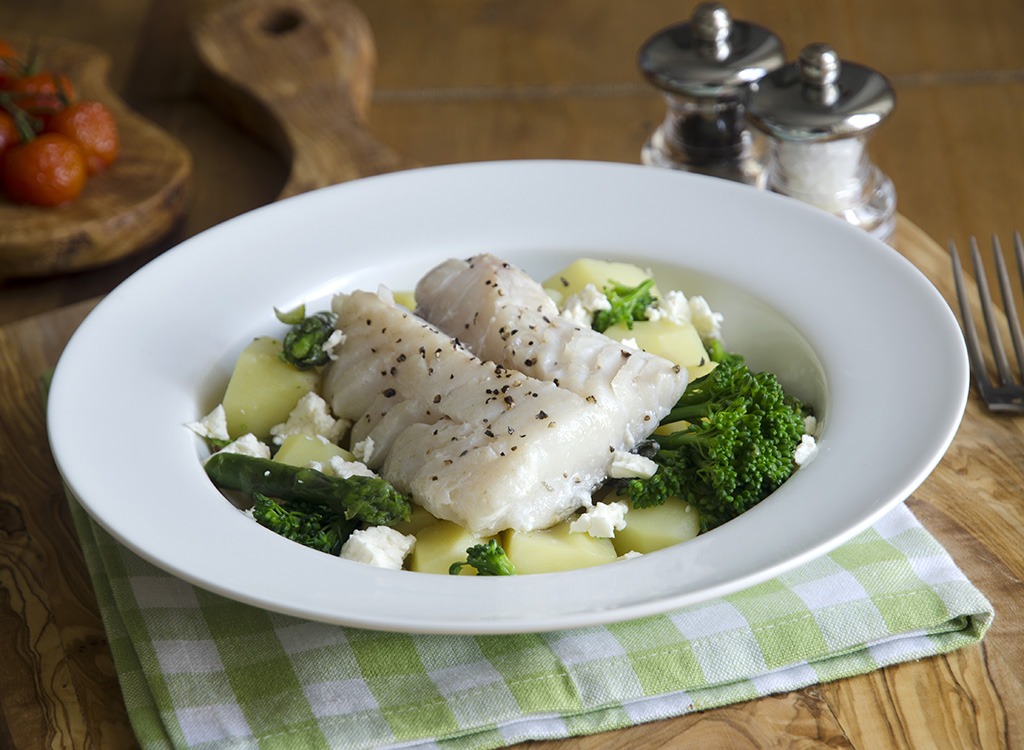

Nutrition (per 3 oz serving): 63 calories, 0.4 g fat (0.1 g saturated fat), 181 mg sodium, 0 g carbs, 0 g fiber, 0 g sugar, 13.9 g protein
Protein (g per 3 oz): 13.9
Omega-3s (mg per 3 oz): 112
Mercury levels (parts per billion): 164
A popular fish of frozen fish and chips (one of the unhealthiest foods on the planet), you can pick this fish up from the store when it’s in season between November and April, as the cold weather makes the flesh firmer. Despite its firmness, Haddock lacks many nutritional benefits, which is why it lands low on our ranking. Substitute it for halibut, another white-fleshed fish with more omega-3s.
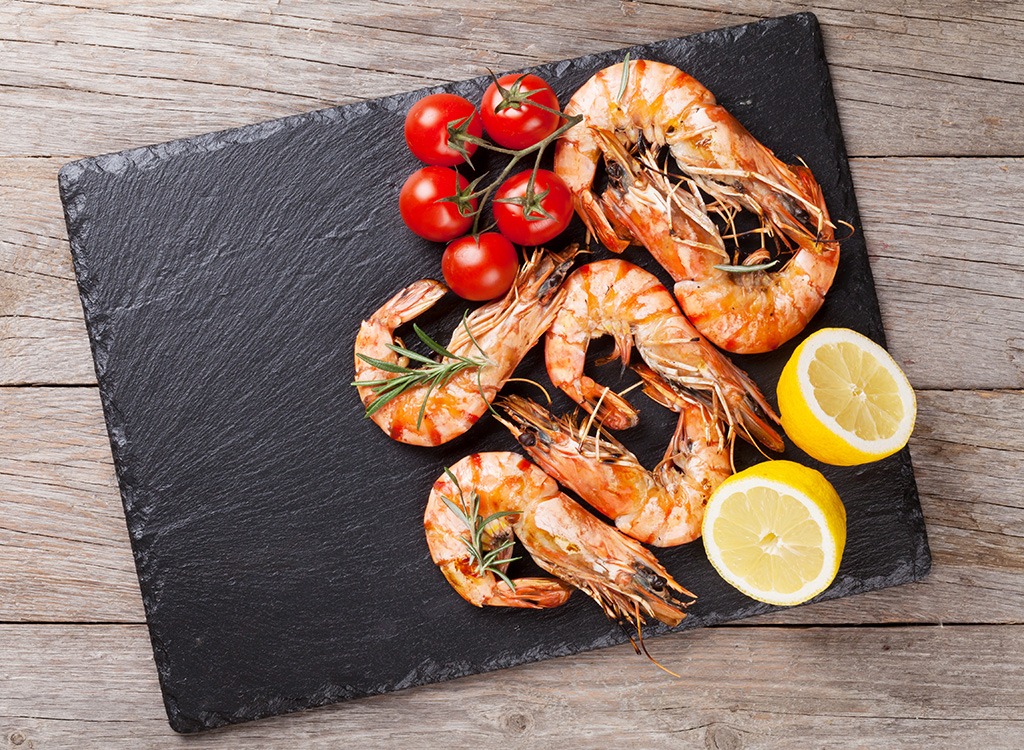

Nutrition (per 3 oz serving): 72 calories, 0.4 g fat (0.1 g saturated fat), 481 mg sodium, 0 g carbs, 0 g fiber, 0 g sugar, 17 g protein
Protein (g per 3 oz): 17
Omega-3s (mg per 3 oz): 52
Mercury levels (parts per billion): 53
The number 1 top US consumed seafood, shrimp is rich in iodine, a building block of your metabolism-running thyroid hormones. Shrimp is a low-fat, low-calorie shellfish that can be enjoyed weekly, due to its low mercury content. Unfortunately, you won’t get many heart-healthy, immunity-boosting omega-3 benefits, but they still taste great with pasta in shrimp scampi or in our Shrimp and Grits recipe.
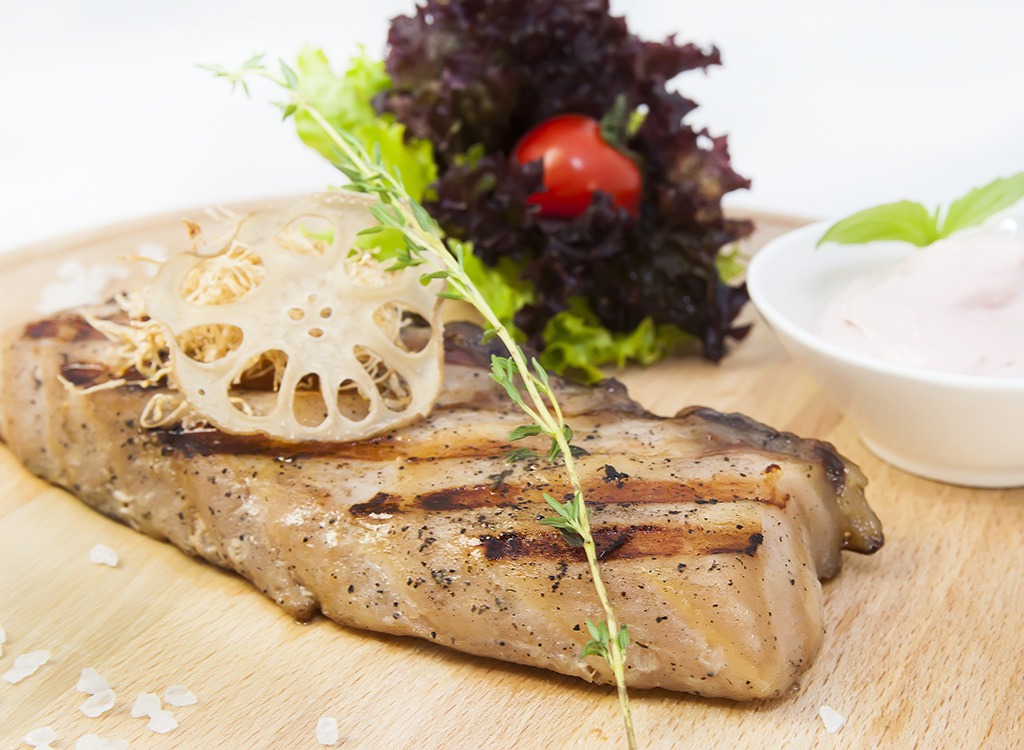

Nutrition (per 3 oz serving): 101 calories, 5 g fat (1.1 g saturated fat), 83 mg sodium, 0 g carbs, 0 g fiber, 0 g sugar, 13 g protein
Protein (g per 3 oz): 13
Omega-3s (mg per 3 oz): 62
Mercury levels (parts per billion): 12
Farmed catfish may be raised in clean, freshwater but they contain significantly fewer valuable omega-3s compared to their wild counterparts. Even though catfish are naturally omnivores, farmed fish are fed unnatural diets of soybeans, corn, and rice.
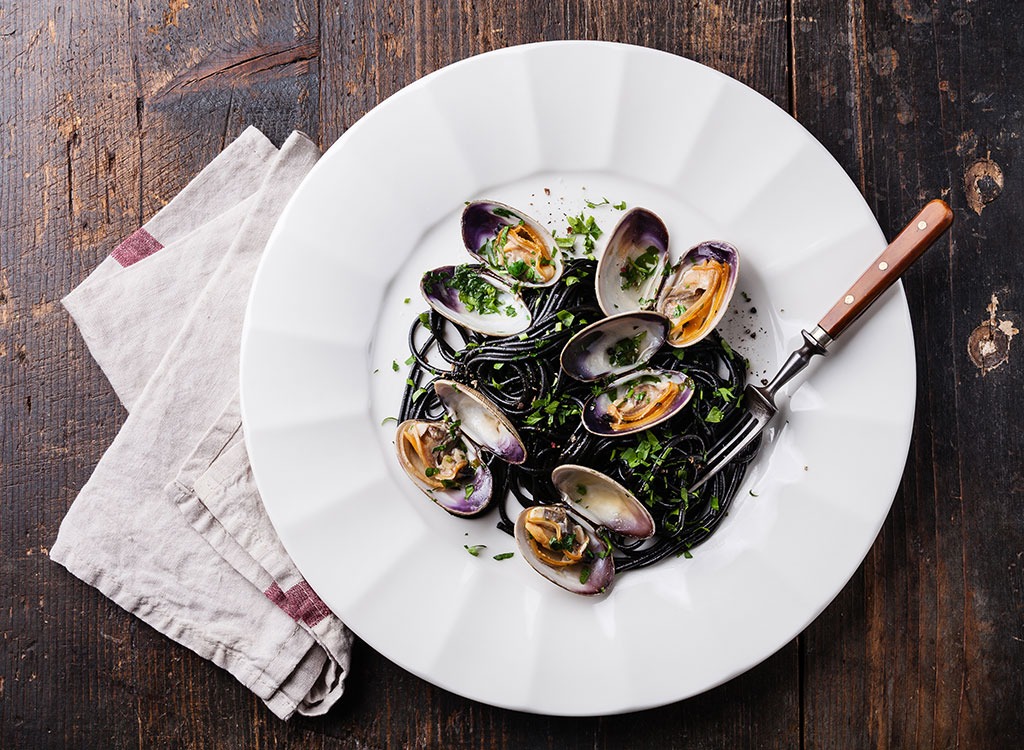

Nutrition (per 3 oz serving): 73 calories, 0.8 g fat (0.2 g saturated fat), 511 mg sodium, 3 g carbs, 0 g fiber, 0 g sugar, 12.5 g protein
Protein (g per 3 oz): 12.5
Omega-3s (mg per 3 oz): 91
Mercury levels (parts per billion): 28
Steamed, littleneck, cockles, you name it. Clams are a hard-shelled fish with an amazing secret: They are the world’s greatest source of Vitamin B12 (according to the FDA, that is). Cooking the little shells bumps up their Vitamin B12 levels to 84 micrograms—that’s 1,402 percent your daily recommended value! Unfortunately, that’s not the only reason we came to the fish party. Clams are seriously lacking on the omega-3 and protein fronts compared to their peers.
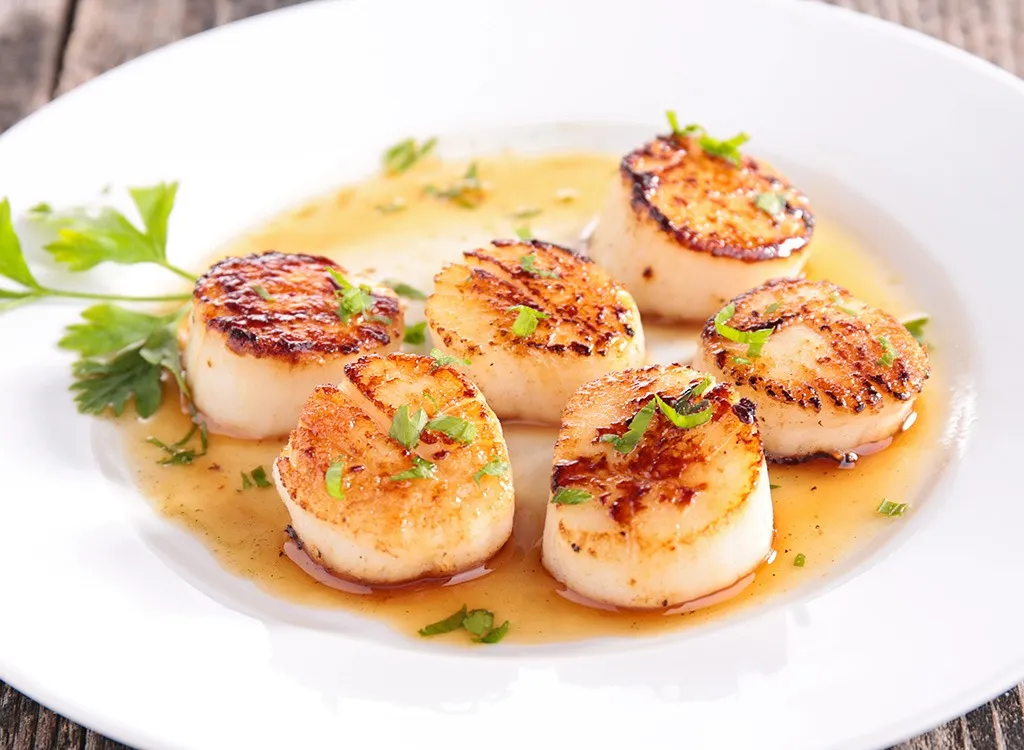

Nutrition (per 3 oz serving): 59 calories, 0.42 g fat (0.1 g saturated fat), 333 mg sodium, 0 g carbs, 0 g fiber, 0 g sugar, 10.3 g protein
Protein (g per 3 oz): 10.3
Omega-3s (mg per 3 oz): 88
Mercury levels (parts per billion): 40
Nope, scallops aren’t ranked so low because they’re often guilty by association with creamy and decadent restaurant sauces (not great for weight loss). Despite being high-protein and low-calorie, these mollusks won’t provide you with a ton of omega-3s. However, they’re still great for your waistline. One study published in the Journal of Food Science found bioactive capsules made from scallop byproducts show significant anti-obesity effects. Throw tiny bay scallops on top of a salad or eat diver scallops with a lemony farro risotto.
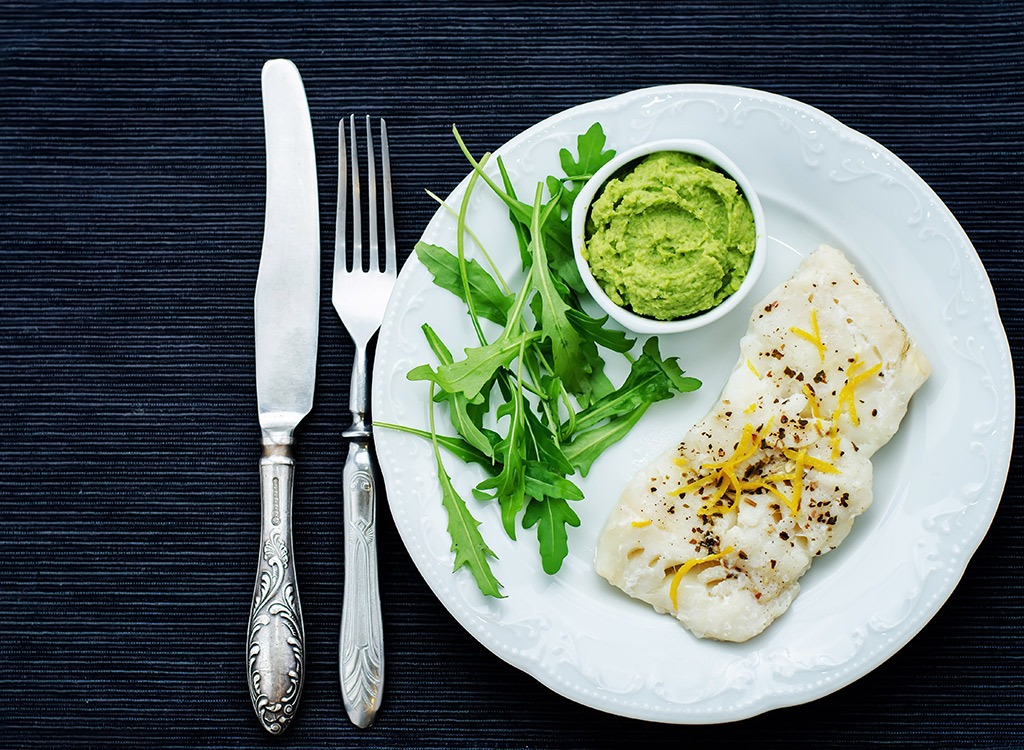

Nutrition (per 3 oz serving): 61 calories, 0.2 g fat (0 g saturated fat), 93 mg sodium, 0 g carbs, 0 g fiber, 0 g sugar, 14.9 g protein
Protein (g per 3 oz): 14.9
Omega-3s (mg per 3 oz): 57
Mercury levels (parts per billion): 144
If you want to salvage any nutritional value from this fish, please don’t bread and fry it for fish sticks. Cod’s high protein content and amino acid profile contribute to the fish’s satiating properties. In fact, a study in the European Journal of Clinical Nutrition found that people ate 11 percent less at dinner after having cod for lunch versus those who ate a beef lunch.


Nutrition (per 3 oz serving): 78 calories, 0.9 g fat (0.2 g saturated fat), 45 mg sodium, 0 g carbs, 0 g fiber, 0 g sugar, 16.5 g protein
Protein (g per 3 oz): 16.5
Omega-3s (mg per 3 oz): 210
Mercury levels (parts per billion): 417
A popular fish in Florida, the grouper is a bottom-eating fish with hearty, but light, meat. This large fish prefers to swallow its prey (including fish, octopi, and crustaceans) whole. Because of its high mercury levels, you’d do best to eat this fish as often as you vacation.
RELATED: 101 Most Dangerous Health Habits, According to Doctors
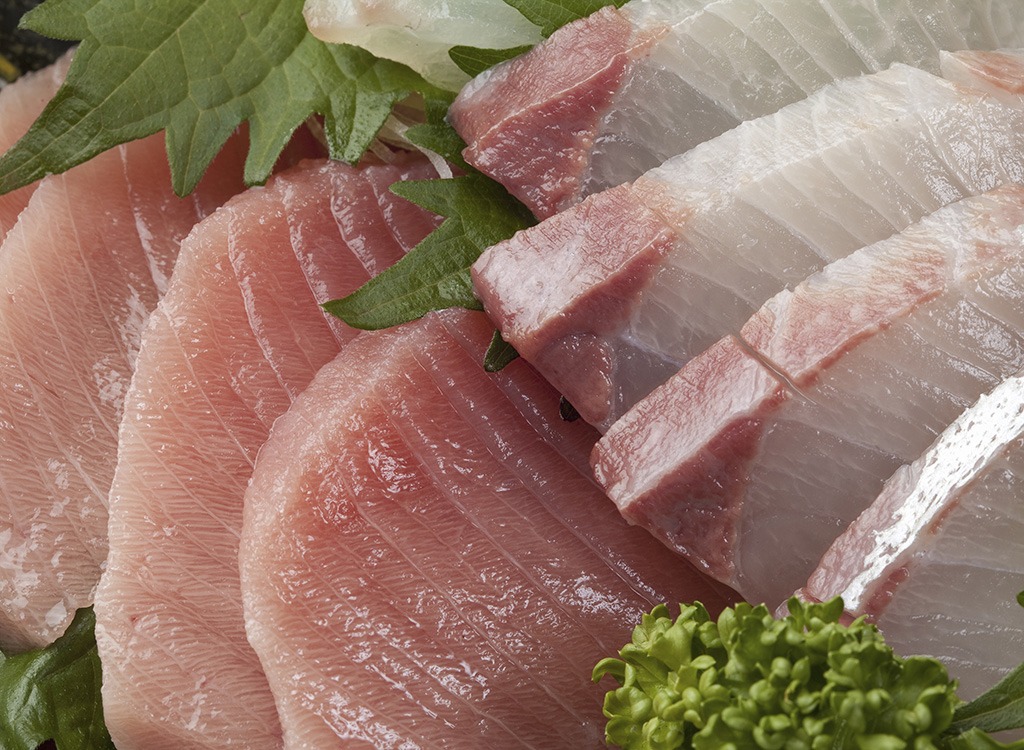

Nutrition (per 3 oz serving): 93 calories, 0.4 g fat (0.1 g saturated fat), 38 mg sodium, 0 g carbs, 0 g fiber, 0 g sugar, 20.7 g protein
Protein (g per 3 oz): 20.7
Omega-3s (mg per 3 oz): 85
Mercury levels (parts per billion): 270
You might see this fish listed on your sushi menu as “Hamachi” or “Buri.” In Tokyo cuisine, “Hamachi” is used to described yellowtail that is farmed. While natural buri swim thousands of miles in their lifetimes, hamachi don’t get much exercise while being farmed in fishnets, resulting in a noticeable difference in the quality of fish oil, and could account for this tuna’s low levels of omega-3s.
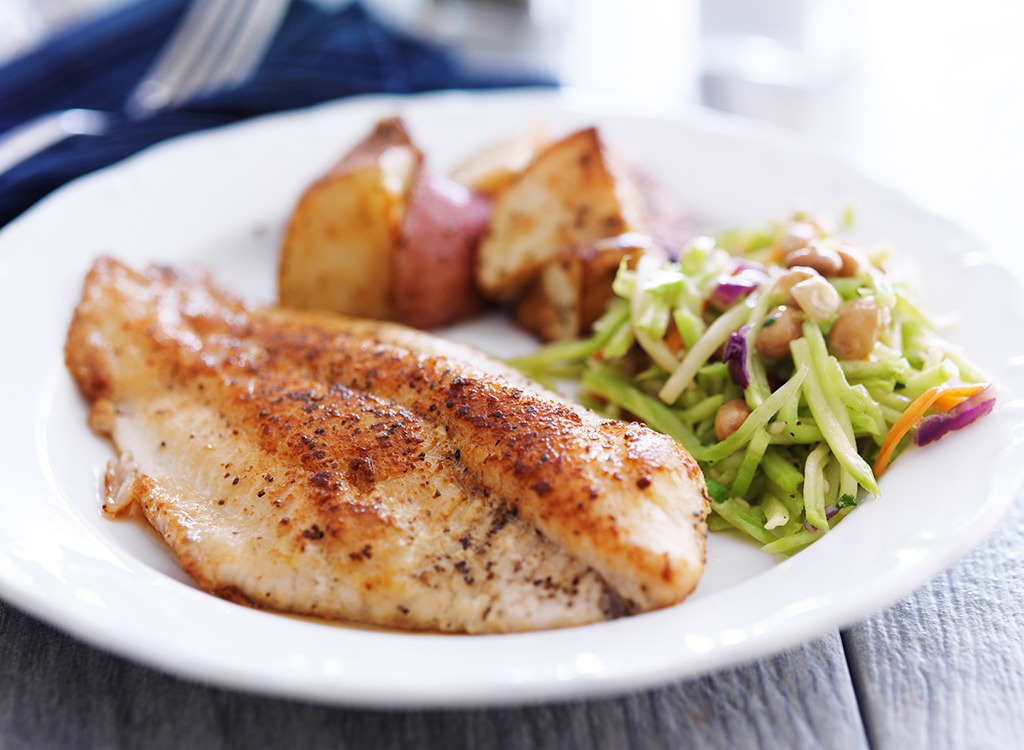

Nutrition (per 3 oz serving): 81 calories, 1.4 g fat (0.5 g saturated fat), 44 mg sodium, 0 g carbs, 0 g fiber, 0 g sugar, 17 g protein
Protein (g per 3 oz): 17
Omega-3s (mg per 3 oz): 77
Mercury levels (parts per billion): 19
Deficient of omega-3s, and typically accompanied by an astronomical level of omega-6s, this fish is worse for your belly than bacon. Additionally, most tilapia is farm-raised and fed a diet of corn instead of lake plants and algae, making them the turducken of seafood: Junk stuffed with junk surrounded by junk.
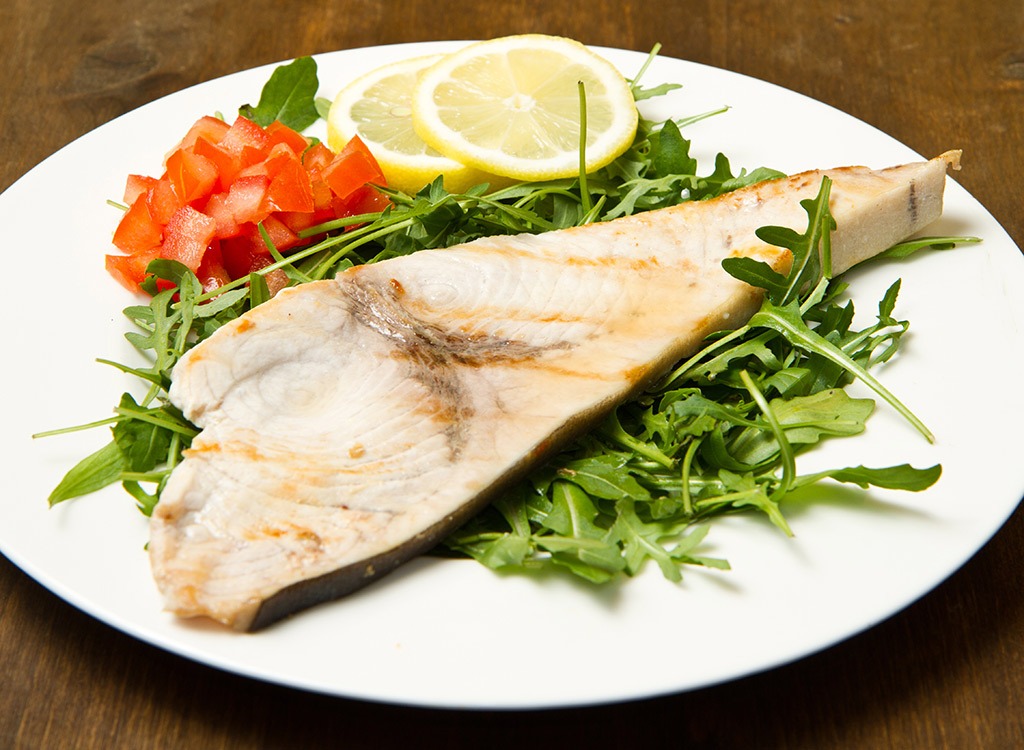

Nutrition (per 3 oz serving): 122 calories, 5.7 g fat (1.4 g saturated fat), 69 mg sodium, 0 g carbs, 0 g fiber, 0 g sugar, 16.7 g protein
Protein (g per 3 oz): 16.7
Omega-3s (mg per 3 oz): 641
Mercury levels (parts per billion): 893
Like all the fish ranked below it, swordfish contains dangerously high levels of mercury, an element which acts as an endocrine disruptor. An endocrine disruptor is a fake hormone that tricks your body into holding on to fat, burning fewer calories, and reducing levels of leptin, a hormone that regulates appetite. The marlin fish, one of this billfish’s cousins, is even worse: It has mercury levels at 1,517 ppb. Its high levels of selenium and vitamin D are what kept it better-for-you than the next big guy…


Nutrition (per 3 oz serving): 110 calories, 3.8 g fat (0.8 g saturated fat), 67 mg sodium, 0 g carbs, 0 g fiber, 0 g sugar, 17.8 g protein
Protein (g per 3 oz): 17.8
Omega-3s (mg per 3 oz): 717
Mercury levels (parts per billion): 882
You should always swim away from sharks, in sea and on land. With terrifying mercury levels at 883 ppb, no amount of omega-3s or protein can justify this catch.
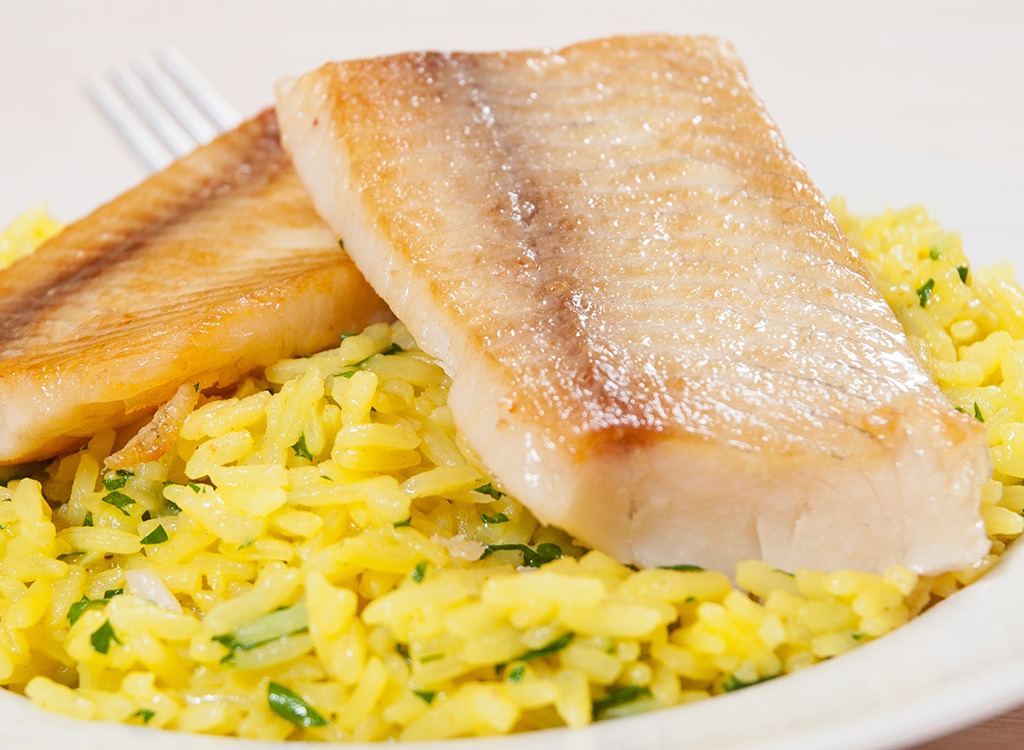

Nutrition (per 3 oz serving): 82 calories, 1.96 g fat (0.4 g saturated fat), 45 mg sodium, 0 g carbs, 0 g fiber, 0 g sugar, 14.9 g protein
Protein (g per 3 oz): 14.9
Omega-3s (mg per 3 oz): 365
Mercury levels (parts per billion): 883
READ RELATED: Black woman, 42, with vitiligo reveals strangers 'fixate on her like she's an animal'
Tilefish has the highest mercury level among all varieties of fish, with 883 parts of mercury per billion. And those you find from the Gulf of Mexico? Mercury levels can reach up to 1,445 ppb! That’s 45% higher than the USDA allowed maximum.
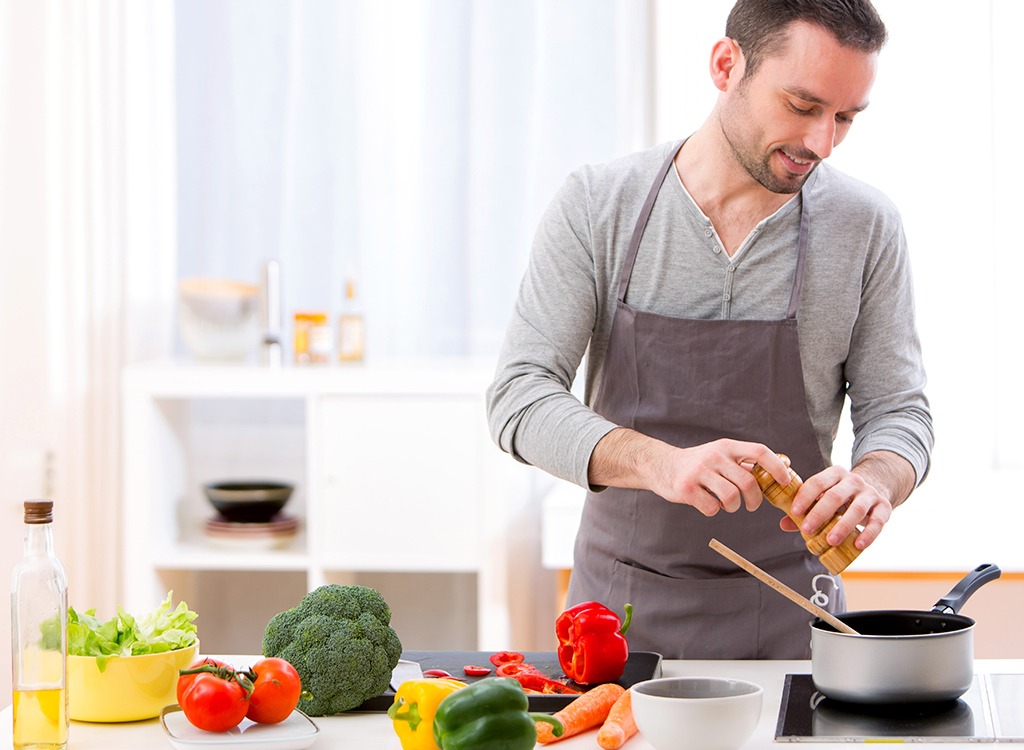

In order to make the best list, these fish had to have moderate levels of mercury or better (less than 350 ppb), be a good source of protein, and have no less than 200 mg of omega-3s. In other words, these fish are actually worth your time and money—and won’t make you sick in exchange for their nutrients.
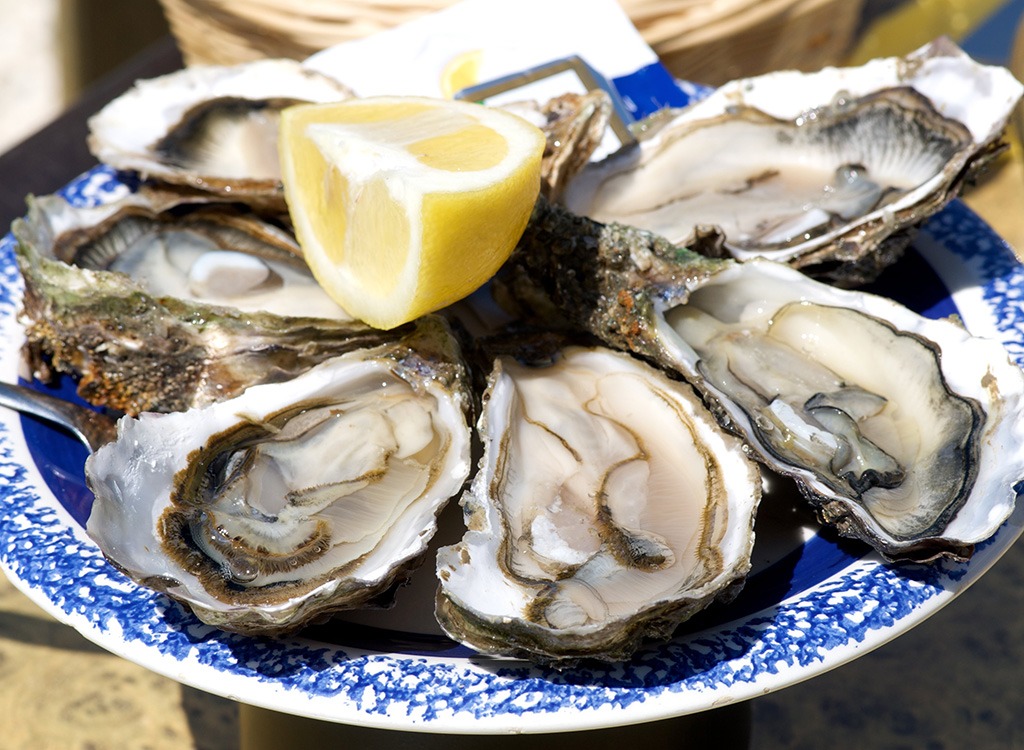

Nutrition (per 3 oz serving): 43 calories, 1.4 g fat (0.4 g saturated fat), 71 mg sodium, 2.3 g carbs, 0 g fiber, 0.5 g sugar, 4.8 g protein
Protein (g per 3 oz): 4.8
Omega-3s (mg per 3 oz): 263
Mercury levels (parts per billion): 18
Compared to these oysters’ pacific cousins, their slightly smaller size means your omega-3 gain is significantly reduced. When looking for the best mollusk, examine their shells: Atlantic oysters have a smoother and rounder shell while Pacific oysters have a sharper and more rigid shell. Why? The Pacific ocean is much rougher than the Atlantic, so oysters hailing from this ocean form a tougher shell to protect themselves. Don’t throw these shells to the side just yet, though. Oysters have been found to be full of iron, and just 6 of these provide 21 percent of your recommended daily allowance. Good news since iron deficiencies have been linked to a significant increase in fat gene expression.
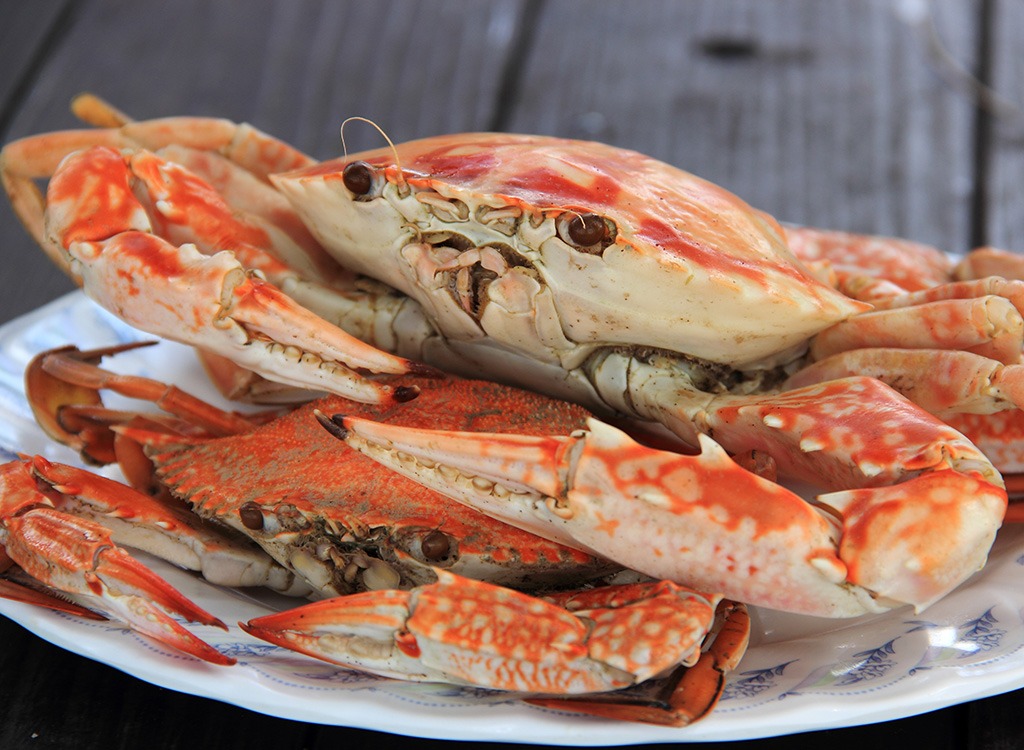

Nutrition (per 3 oz serving): 73 calories, 0.8 g fat (0.1 g saturated fat), 251 mg sodium, 0 g carbs, 0 g fiber, 0 g sugar, 14.8 g protein
Protein (g per 3 oz): 14.8
Omega-3s (mg per 3 oz): 261
Mercury levels (parts per billion): 120
Earning its name from a town in Washington where it’s found, Dungeness crabs live in the chilly Pacific waters on the West Coast. While not a top source of omega-3s per ounce, when it comes to serving size, a single crab is just under 6 ounces, so if you eat the whole thing, you’re looking at 28 grams of protein and 500 mg omega-3s per crab. Besides filling your belly, you can ease your mind knowing that Seafood Watch—one of the most popular sustainable seafood advisory lists—has given the crab a sustainable seafood rating of “Best Choice.”


Nutrition (per 3 oz serving): 77 calories, 0.8 g fat (0.2 g saturated fat), 53 mg sodium, 0 g carbs, 0 g fiber, 0 g sugar, 16.5 g protein
Protein (g per 3 oz): 16.5
Omega-3s (mg per 3 oz): 215
Mercury levels (parts per billion): 141
Perch are a popular sport fish species because they put up a good fight. That fight certainly pays off with some good protein and healthy fats.
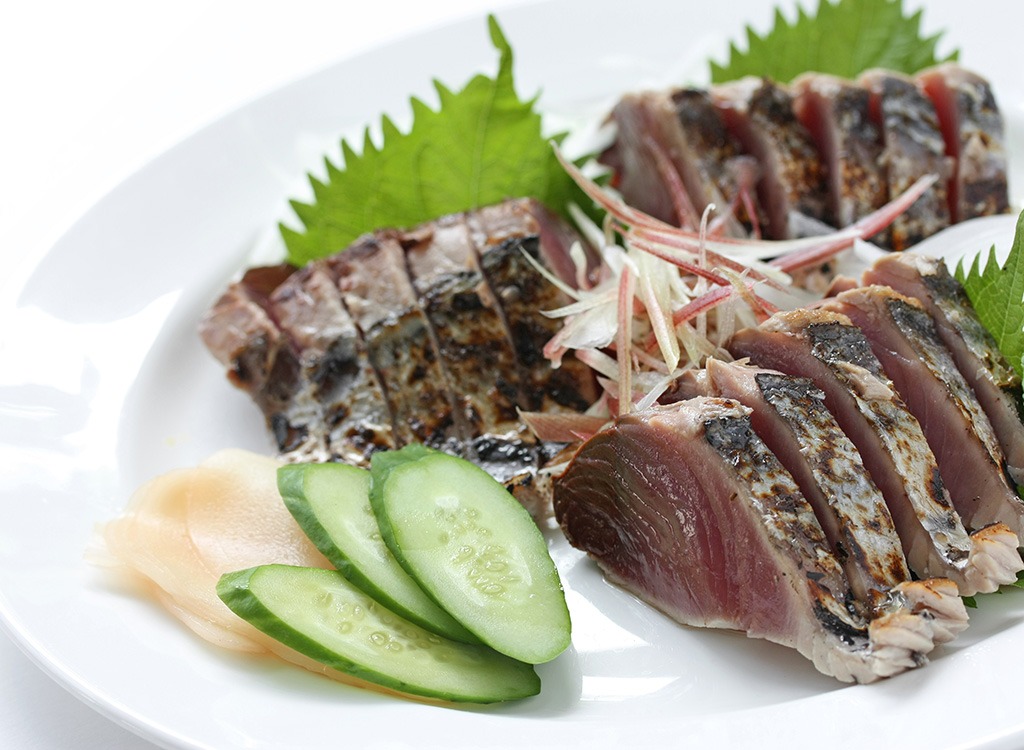

Nutrition (per 3 oz serving): 88 calories, 0.9 g fat (0.3 g saturated fat), 31 mg sodium, 0 g carbs, 0 g fiber, 0 g sugar, 18.7 g protein
Protein (g per 3 oz): 18.7
Omega-3s (mg per 3 oz): 217
Mercury levels (parts per billion): 198
Skipjack tuna is smaller than its yellowfin cousin, which helps it to soaks up fewer toxins. Even with its smaller size, it still has almost 200 ppb of mercury, so be mindful of the frequency of which you eat it—especially if you buy bulk-buying mecca Costco’s new sustainable (and affordable) skipjack tuna brand. What is sustainable tuna? It’s tuna that is FAD-free: fish aggregating devices (FADs) are large nets that can kill sharks, rays, and turtles that are caught along with the tuna.
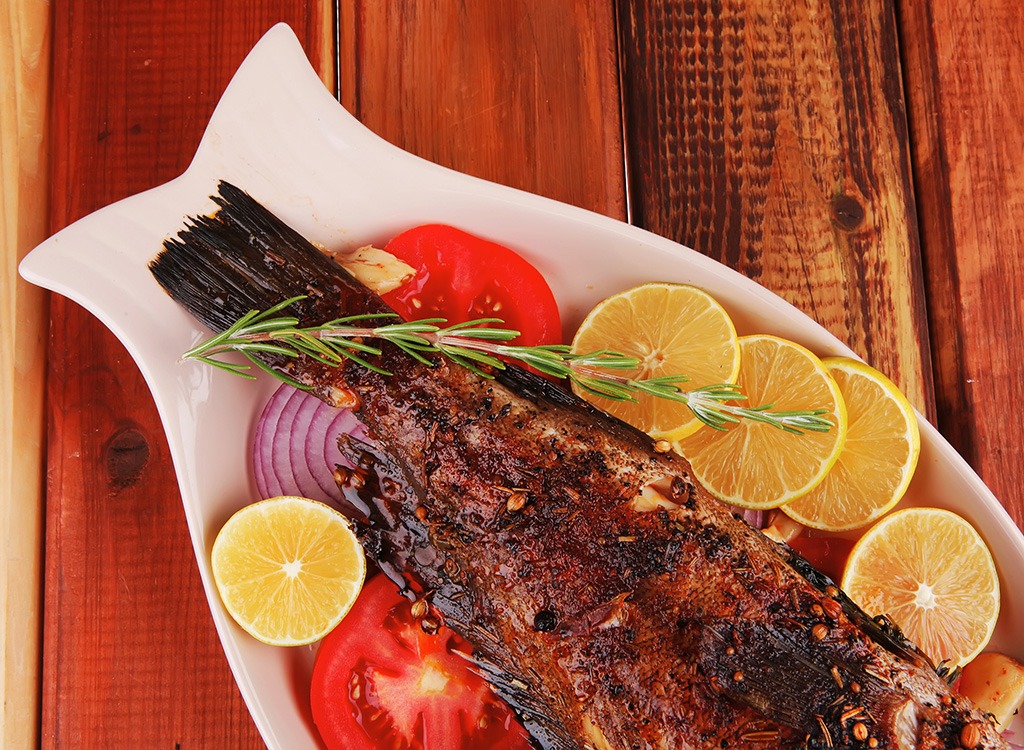

Nutrition (per 3 oz serving): 82 calories, 1.7 g fat (0.4 g saturated fat), 58 mg sodium, 0 g carbs, 0 g fiber, 0 g sugar, 15.7 g protein
Protein (g per 3 oz): 15.7
Omega-3s (mg per 3 oz): 506
Mercury levels (parts per billion): 120
This petite fish inhabits the eastern coast, from Maine to Florida. Besides finding it in restaurants, the black sea bass is also a popular recreational catch. Chilean sea bass, however, shouldn’t be consumed as often as its mercury levels are 357 ppb.


Nutrition (per 3 oz serving): 82 calories, 2 g fat (0.4 g saturated fat), 59 mg sodium, 0 g carbs, 0 g fiber, 0 g sugar, 15 g protein
Protein (g per 3 oz): 15
Omega-3s (mg per 3 oz): 641
Mercury levels (parts per billion): 295
Stripers are a long-lived species, and many live to over 30 years of age. Their long life may expose them to and influence their increased levels of mercury, which accounts for the 295 ppb. It’s also a reason for their large size—the world record for striped bass is over 81 pounds! And all that meat is packed with omega-3s and vitamin B12.
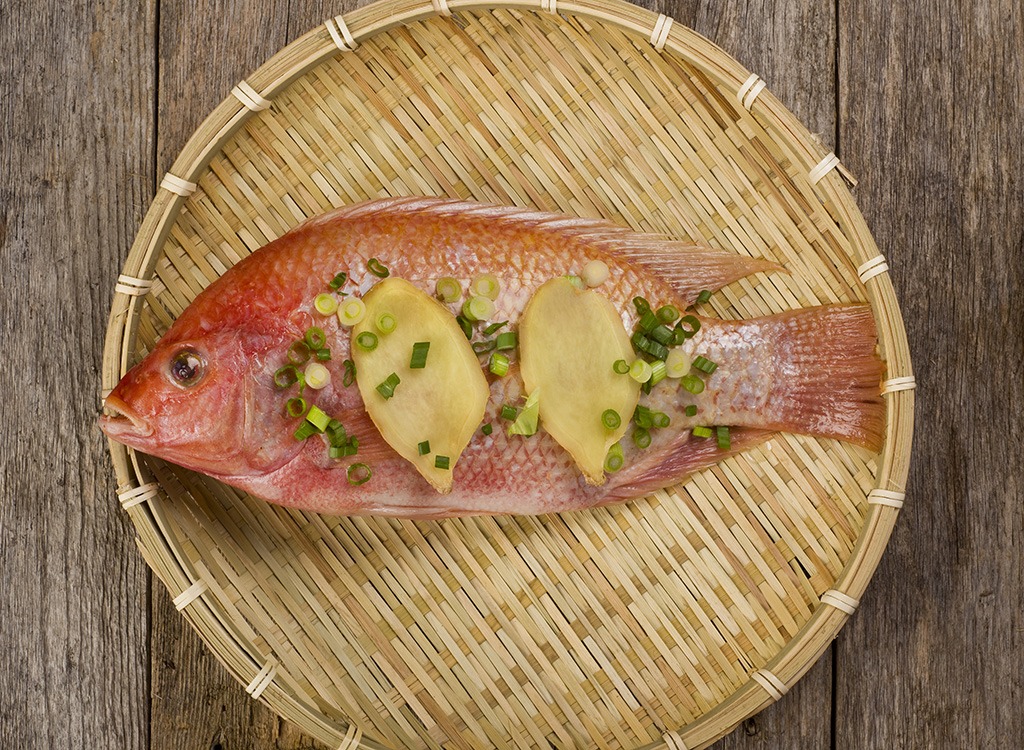

Nutrition (per 3 oz serving): 85 calories, 1.1 g fat (0.2 g saturated fat), 54 mg sodium, 0 g carbs, 0 g fiber, 0 g sugar, 17.4 g protein
Protein (g per 3 oz): 17.4
Omega-3s (mg per 3 oz): 264
Mercury levels (parts per billion): 230
The Red Snapper is one of the Gulf of Mexico’s signature fish. For many commercial fishermen, it’s primarily where their profits come from. In fact, back in 2011, Gulf fishermen harvested 3.6 million pounds of red snapper that were valued at $11.4 million. We’re definitely on board with its popularity—the fish is a great source of lean protein to help build muscle, boost your metabolism, and increase feelings of fullness.
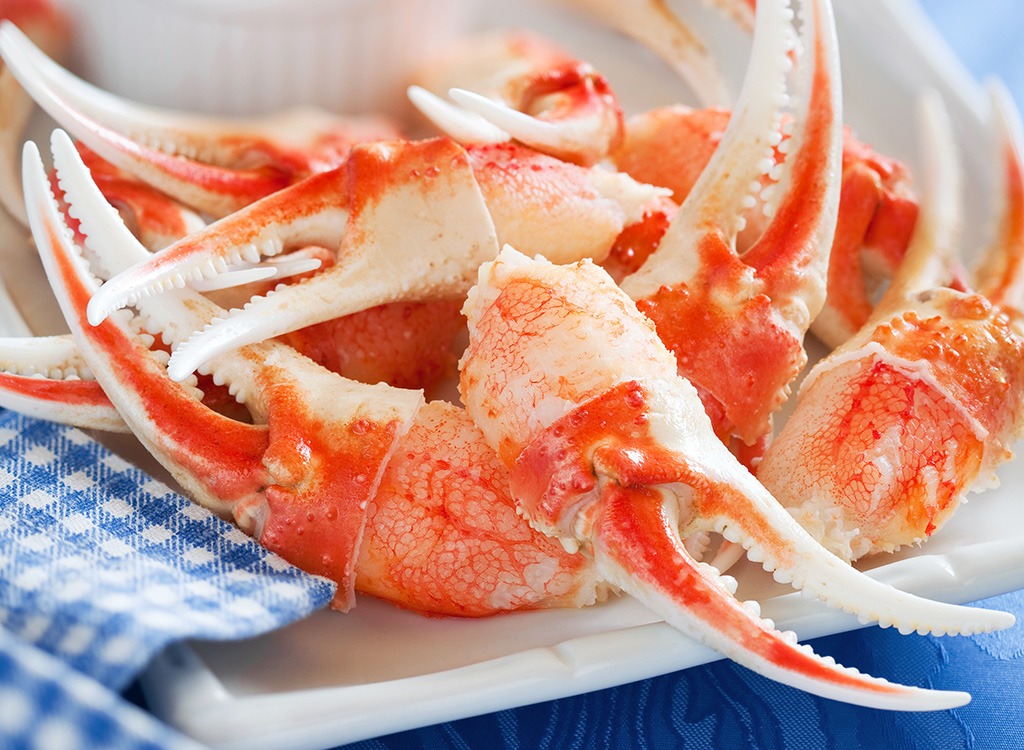

Nutrition (per 3 oz serving): 74 calories, 0.9 g fat (0.2 g saturated fat), 249 mg sodium, 0 g carbs, 0 g fiber, 0 g sugar, 15.4 g protein
Protein (g per 3 oz): 15.4
Omega-3s (mg per 3 oz): 273
Mercury levels (parts per billion): 95
These blueclaws are found on the Atlantic coast, and will most certainly be the crab of choice if you ever visit a Maryland crab restaurant. You’ll have to eat four of the crustaceans to meet the 3-ounce serving, but we don’t think that’ll be too much of a problem if you belly up to an old-fashioned crab shack.
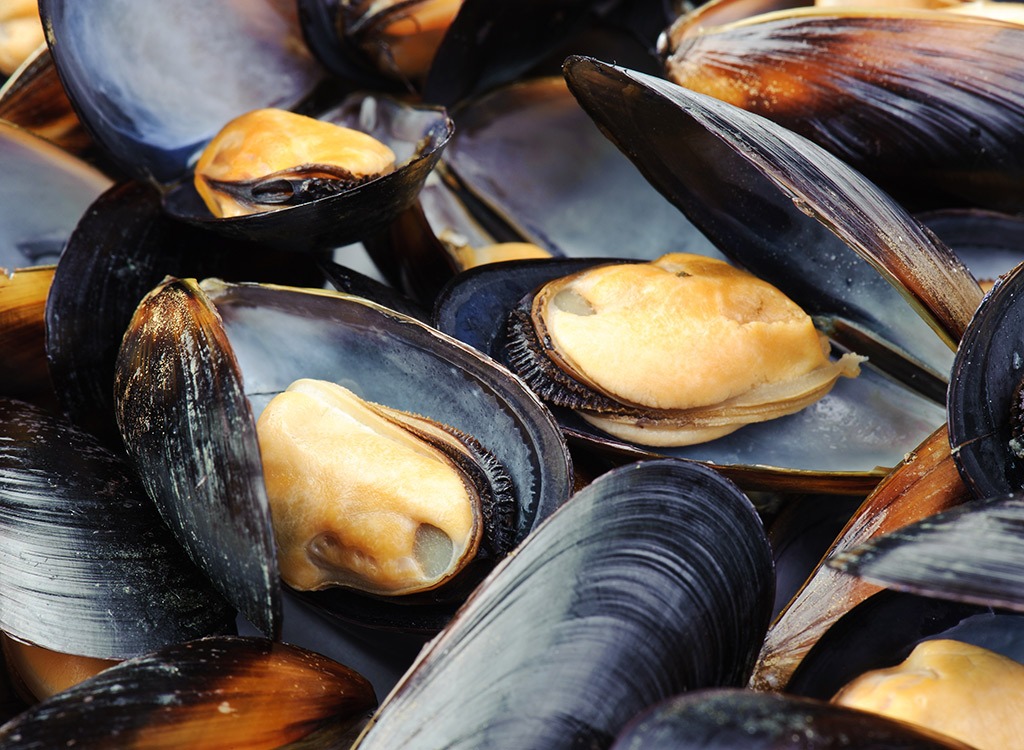

Nutrition (per 3 oz serving): 73 calories, 1.9 g fat (0.4 g saturated fat), 243 mg sodium, 0 g carbs, 0 g fiber, 0 g sugar, 10.1 g protein
Protein (g per 3 oz): 10.1
Omega-3s (mg per 3 oz): 375
Mercury levels (parts per billion): 28
Farmed or wild, mussels are a great source of protein and omega-3s and a super source of vitamin B12 with 170 percent of your daily recommended intake per 3 ounces (which is equivalent to only five mussels—way fewer than you’ll get in any classic mussel dish). It turns out, farmed mussels are raised in an environmentally responsible manner that may actually improve the surrounding marine environment.


Nutrition (per 3 oz serving): 78 calories, 1.2 g fat (0.3 g saturated fat), 37 mg sodium, 0 g carbs, 0 g fiber, 0 g sugar, 13.2 g protein
Protein (g per 3 oz): 13.2
Omega-3s (mg per 3 oz): 415
Mercury levels (parts per billion): 44
Technically, and quite surprisingly, a squid is a type of mollusk: the same family as mussels and clams. This is because squid used to have a shell just like these other shellfish, but over time, it was reduced down to a pen-like structure. Well, use that pen to write down squid (or calamari) on your grocery list. Squid is so high in omega-3s that it’s a source of omega-3 supplement oil.


Nutrition (per 3 oz serving): 101 calories, 2.9 g fat (0.6 g saturated fat), 26 mg sodium, 0 g carbs, 0 g fiber, 0 g sugar, 17.4 g protein
Protein (g per 3 oz): 17.4
Omega-3s (mg per 3 oz): 499
Mercury levels (parts per billion): 344
Following a rainbow can lead you to a pot of gold: a lean protein and omega-3 pot of gold, that is. Because of moderate PCB contamination due to their lake habitats, the Environmental Defense Fund (EDF) recommends kids limit consumption to two to three meals a month, depending on their age.
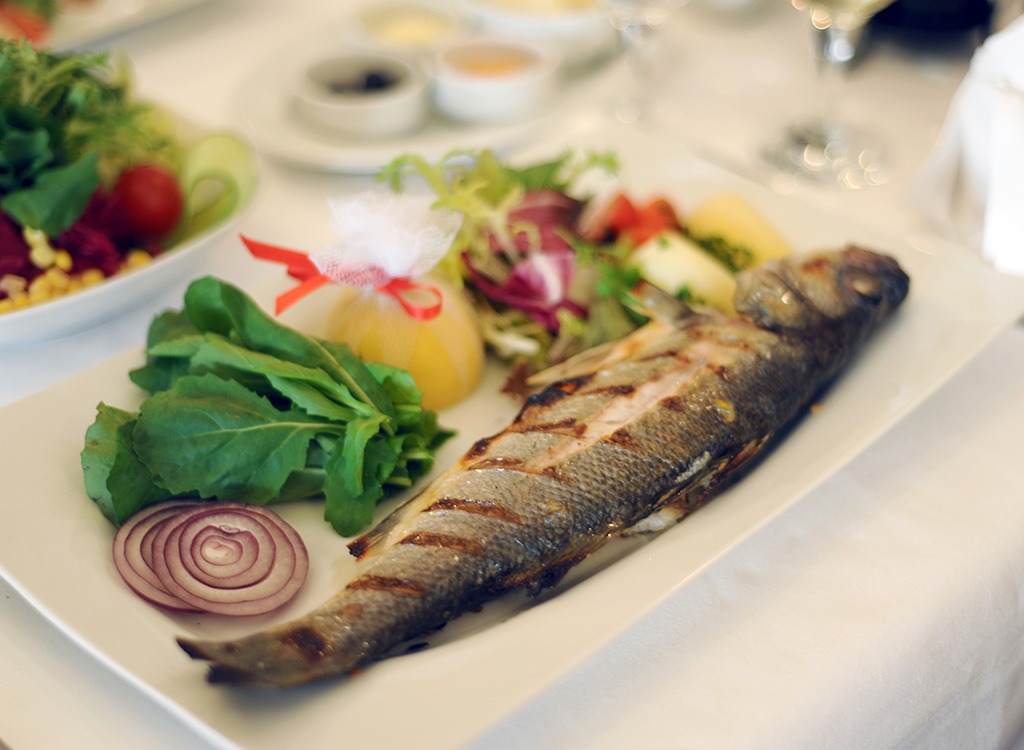

Nutrition (per 3 oz serving): 105 calories, 3.6 g fat (0.8 g saturated fat), 51 mg sodium, 0 g carbs, 0 g fiber, 0 g sugar, 17 g protein
Protein (g per 3 oz): 17
Omega-3s (mg per 3 oz): 655
Mercury levels (parts per billion): 350
These fish are strong and aggressive, which is why lifeguards are taught to remove swimmers from the water when they see any signs of bluefish feeding frenzies. During these frenzies, bluefish will continue to attack and eat anything in their way even after they’ve eaten their fill. (Sounds just like what happens after you eat these 24 foods that make you hungrier.) This overeating is most likely the reason that bluefish have a fairly high mercury level. Because of the medium levels of mercury, be sure to consume this fish in moderation, but when you do, it’ll give you a great source of omega-3s and lean protein.
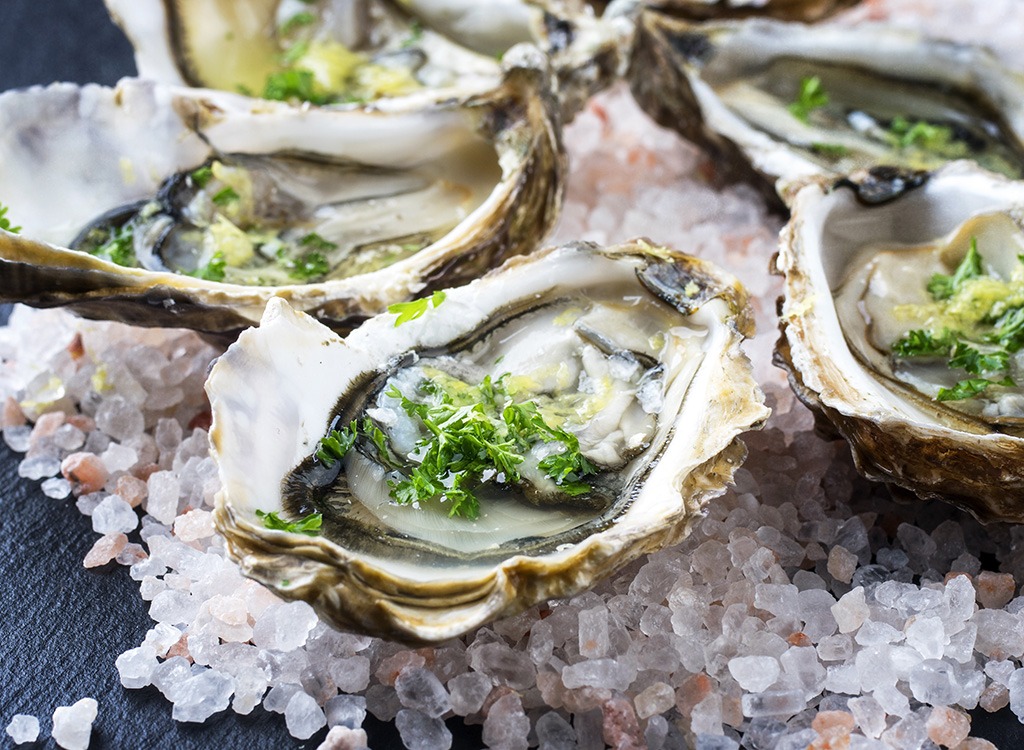

Nutrition (per 3 oz serving): 69 calories, 2 g fat (0.4 g saturated fat), 90 mg sodium, 4.2 g carbs, 0 g fiber, 0 g sugar, 8 g protein
Protein (g per 3 oz): 8
Omega-3s (mg per 3 oz): 584
Mercury levels (parts per billion): 39
While oysters’ protein per ounce may appear low at first, shuck a plate of just six of these pearl-yielding mollusks, and your protein profit skyrockets to 28 grams along with 2,064 mg of omega-3s. The anti-inflammatory properties of omega-3s aren’t the only benefit of eating oysters. In fact, their high levels of zinc may help brighten your mood, but could also be the root of their well-known reputation as an aphrodisiac. A study in Nutrition found that six months of zinc supplementation among slightly zinc-deficient elderly men doubled serum levels of testosterone—the hormone whose levels reflect libido.
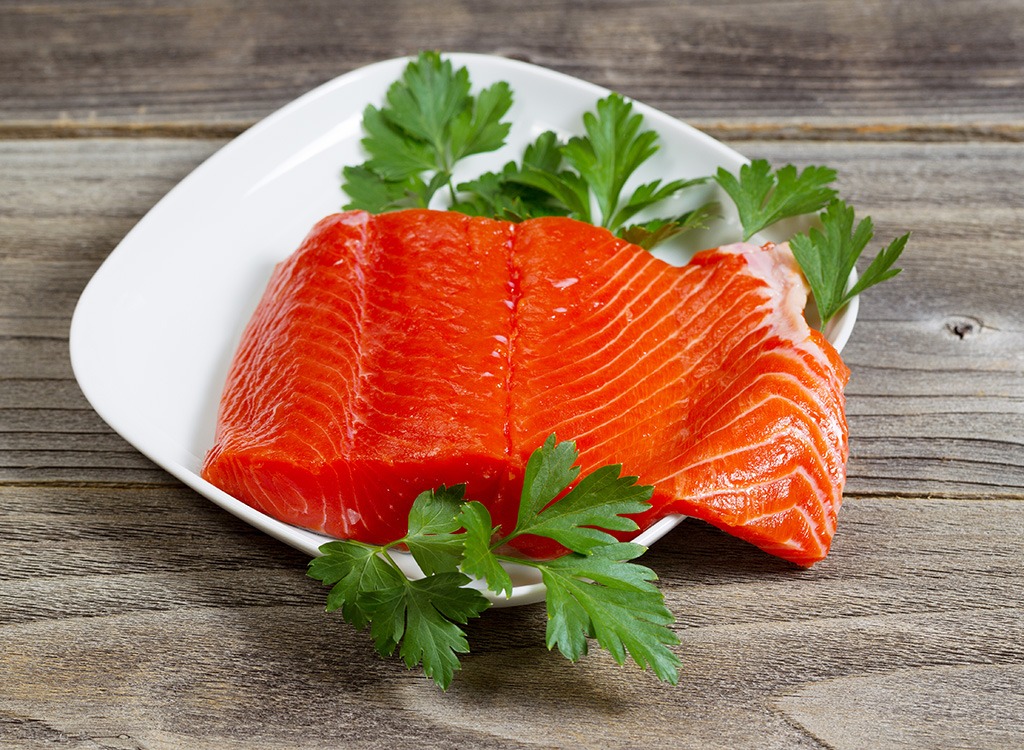

Nutrition (per 3 oz serving): 111 calories, 4 g fat (0.7 g saturated fat), 66 mg sodium, 0 g carbs, 0 g fiber, 0 g sugar, 18.9 g protein
Protein (g per 3 oz): 6.3
Omega-3s (mg per 3 oz): 613
Mercury levels (parts per billion): 39
Sockeye salmon is much deeper in red than other salmon species because it noshes on krill, a type of small shrimp. Besides being a great source of omega-3s, a 3-ounce portion ranks as your seventh best source of vitamin D, with 112 percent of your recommended intake. This sun vitamin is rarely found in food but is important in warding off breast and prostate cancer as well as boosting heart health.
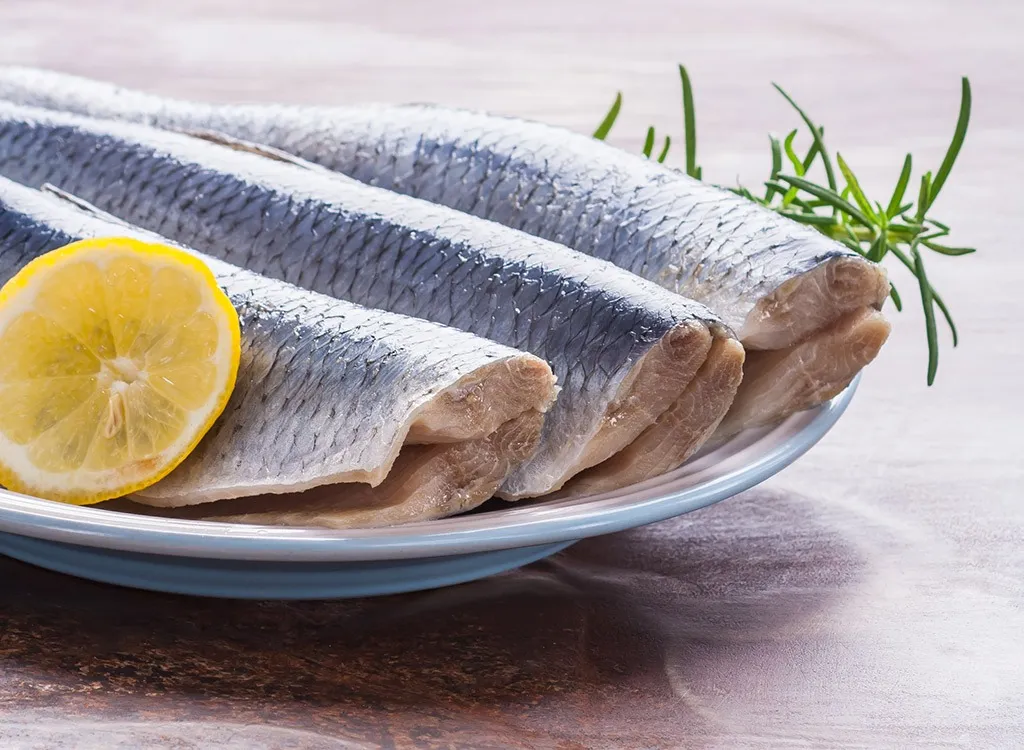

Nutrition (per 3 oz serving): 134 calories, 7.7 g fat (1.7 g saturated fat), 76 mg sodium, 0 g carbs, 0 g fiber, 0 g sugar, 15.3 g protein, 56% RDA Selenium, 484% RDA Vitamin B12
Protein (g per 3 oz): 15.3
Omega-3s (mg per 3 oz): 1,336
Mercury levels (parts per billion): 43
Herring is the superfood of the sea. Besides being one of this list’s top three sources of omega-3s per ounce, herring is also one of the best sources of vitamin B12—over 160 percent RDI per ounce—and vitamin D—11 percent RDI per ounce. When it comes to cooking, grill herring and dress with a mixture of mustard, lemon juice and its own oil for a dinner packed with protein and healthy fats. Serve with a side of sautéed kale and some quinoa to round out your plate.
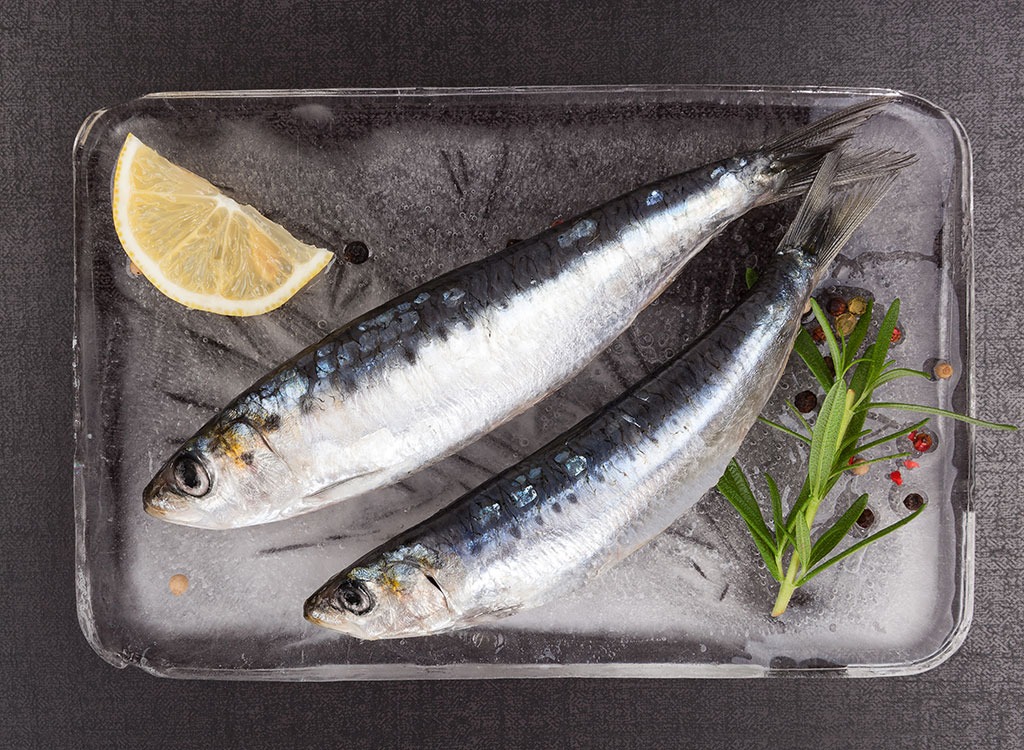

Nutrition (per 3 oz serving): 111 calories, 4.11 g fat (1.1 g saturated fat), 88 mg sodium, 0 g carbs, 0 g fiber, 0 g sugar, 17.3 g protein
Protein (g per 3 oz): 17.3
Omega-3s (mg per 3 oz): 1,231
Mercury levels (parts per billion): 103
You may already use it in your Caesar salad dressings, but anchovies’ omega-3 levels of five times your recommended daily intake might give you reason to find more ways to introduce this power food into your cooking arsenal. Try it in our prime rib with Italian herb sauce.
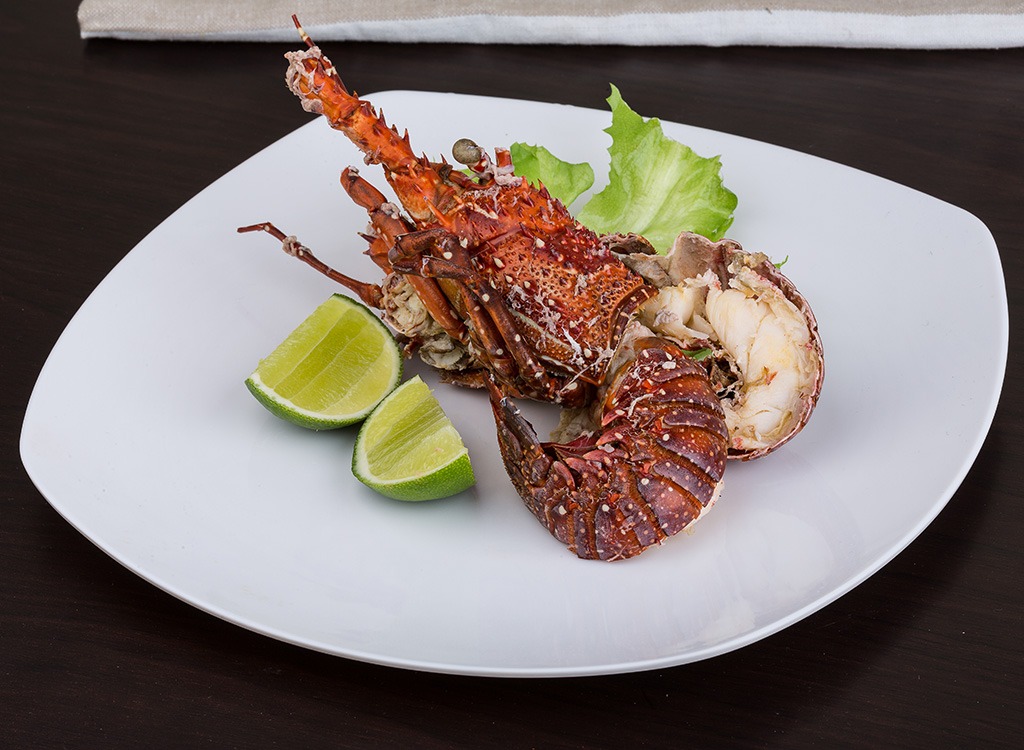

Nutrition (per 3 oz serving): 95 calories, 1.3 g fat (0.2 g saturated fat), 150 mg sodium, 0 g carbs, 0 g fiber, 0 g sugar, 17.5 g protein
Protein (g per 3 oz): 17.5
Omega-3s (mg per 3 oz): 317
Mercury levels (parts per billion): 100
This lobster lacks the terrifying claws characteristic of its Maine cousin but makes up for it in its abundance of protruding barbs. Typically found in warmer seas in the Caribbean and Mediterranean, their tails are packed with omega-3s, and the whole lobster provides 122 percent of your daily recommended vitamin B12, a vitamin unique to animal sources that facilitates proper nerve function.
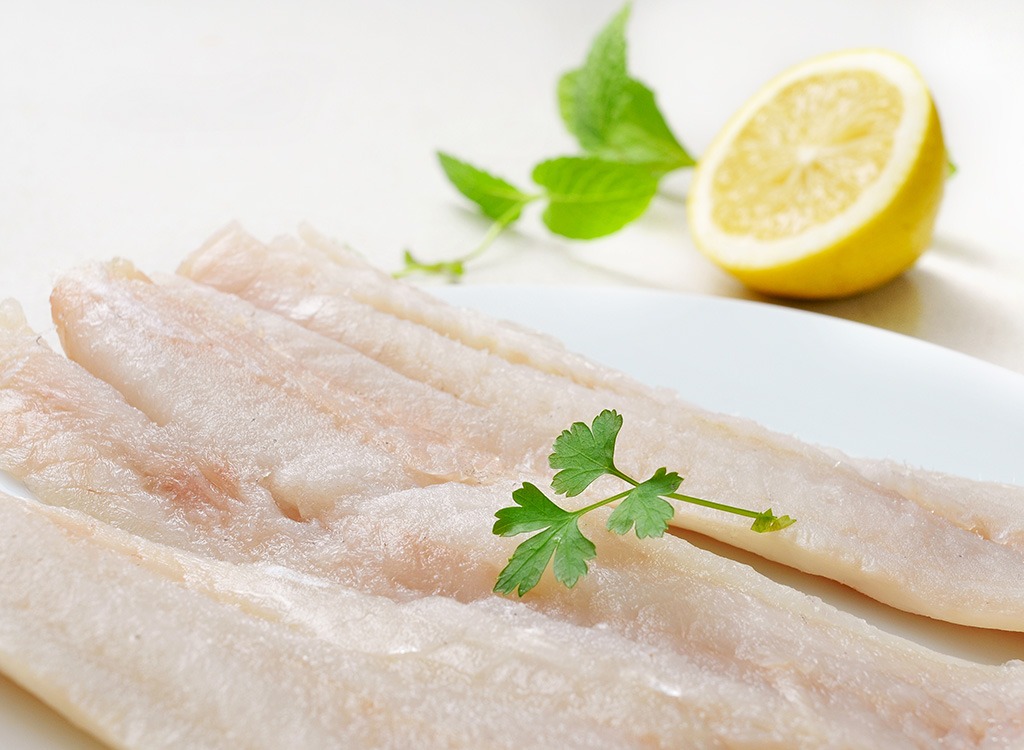

Nutrition (per 3 oz serving): 78 calories, 0.8 g fat (0.1 g saturated fat), 73 mg sodium, 0 g carbs, 0 g fiber, 0 g sugar, 16.5 g protein
Protein (g per 3 oz): 16.5
Omega-3s (mg per 3 oz): 358
Mercury levels (parts per billion): 160
Despite their shared name, Atlantic pollock are larger and darker than the Alaskan pollock, which is actually a different species. Another big difference? The Atlantic fish has a much higher omega-3 content. Its mild flavor and delicate texture makes it extremely versatile, so feel free to dress it up however you’d like!


Nutrition (per 3 oz serving): 177 calories, 9.7 g fat (1.3 g saturated fat), 261 mg sodium, 0 g carbs, 0 g fiber, 0 g sugar, 21 g protein
Protein (g per 3 oz): 21
Omega-3s (mg per 3 oz): 835
Mercury levels (parts per billion): 79
The smaller the fish, the smaller the amount of mercury. These tiny fish typically come from the Pacific. Despite their diminutive size, they pack a nutritional punch (which is why they’re one of the superfoods you need). A mere 3 ounces provides 12 percent your recommended daily intake of vitamin D and 64 percent of selenium, a mineral that plays a key role in metabolism, immunity, and reproductive health. Canned versions are known to be high in sodium, so be sure to consume them in moderation or look for low-sodium canned versions.
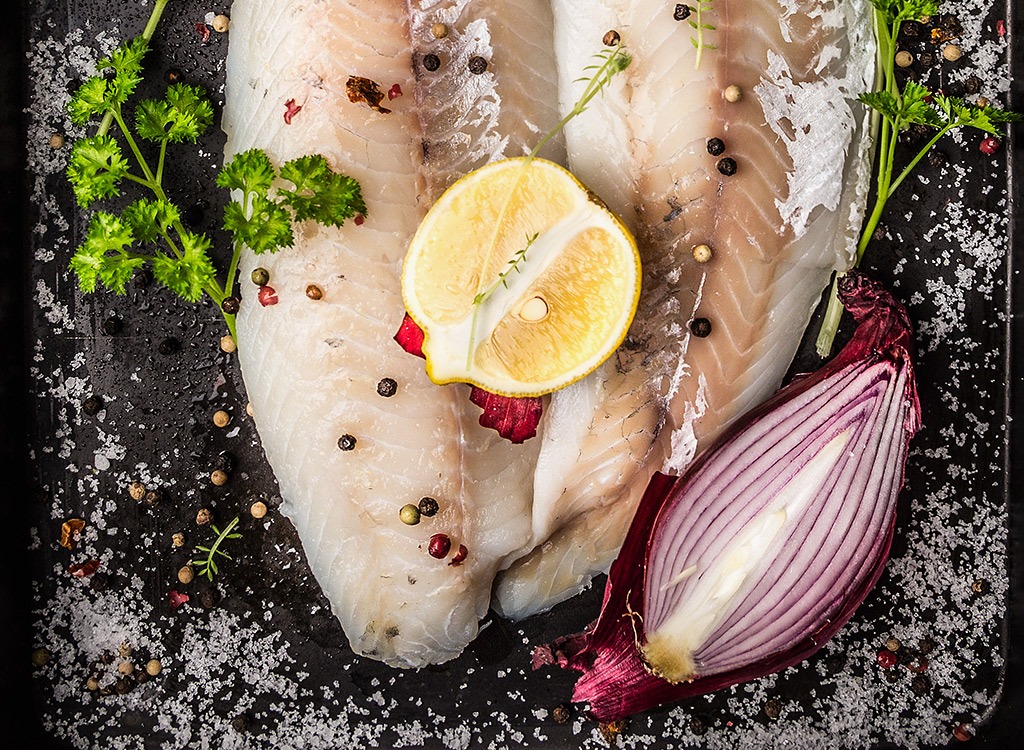

Nutrition (per 3 oz serving): 186 calories, 2.7 g fat (0.6 g saturated fat), 139 mg sodium, 0 g carbs, 0 g fiber, 0 g sugar, 37.9 g protein
Protein (g per 3 oz): 37.9
Omega-3s (mg per 3 oz): 396 (0.135 + 0.261
Mercury levels (parts per billion): 261
This meaty white fish’s mild flavor makes it immensely versatile. Besides being low-cal, it’s also filling—making it a great weight-loss food. According to “The Satiety Index of Common Foods,” published in the European Journal of Clinical Nutrition, halibut ranks the second most filling food—bested only by boiled potatoes. Study authors attribute the filling factor of white fish like halibut to its impressive protein content and influence on serotonin, one of the key hormones responsible for regulating appetite. Try eating more Pacific than Atlantic fish since the Atlantic halibut is low in numbers.
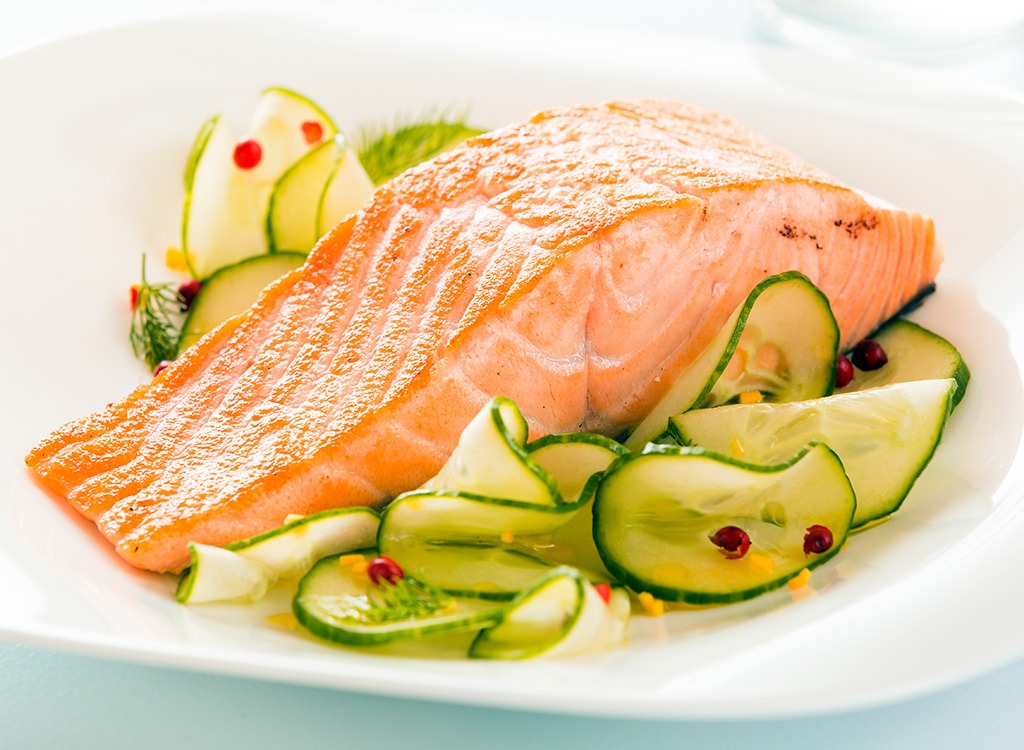

Nutrition (per 3 oz serving): 108 calories, 3.5 g fat (0.7 g saturated fat), 64 mg sodium, 0 g carbs, 0 g fiber, 0 g sugar, 17.4 g protein
Protein (g per 3 oz): 17.4
Omega-3s (mg per 3 oz): 438
Mercury levels (parts per billion): 37
Pink salmon, also known as humpback salmon because of male’s distinctive humpback that occurs during their spawning phase, is native to the cold waters of the Pacific and Arctic Oceans. If eating muscle-building protein and heart-healthy omega-3 levels isn’t for you, you can also chow down on this fish’s roe, which is a common source for caviar.
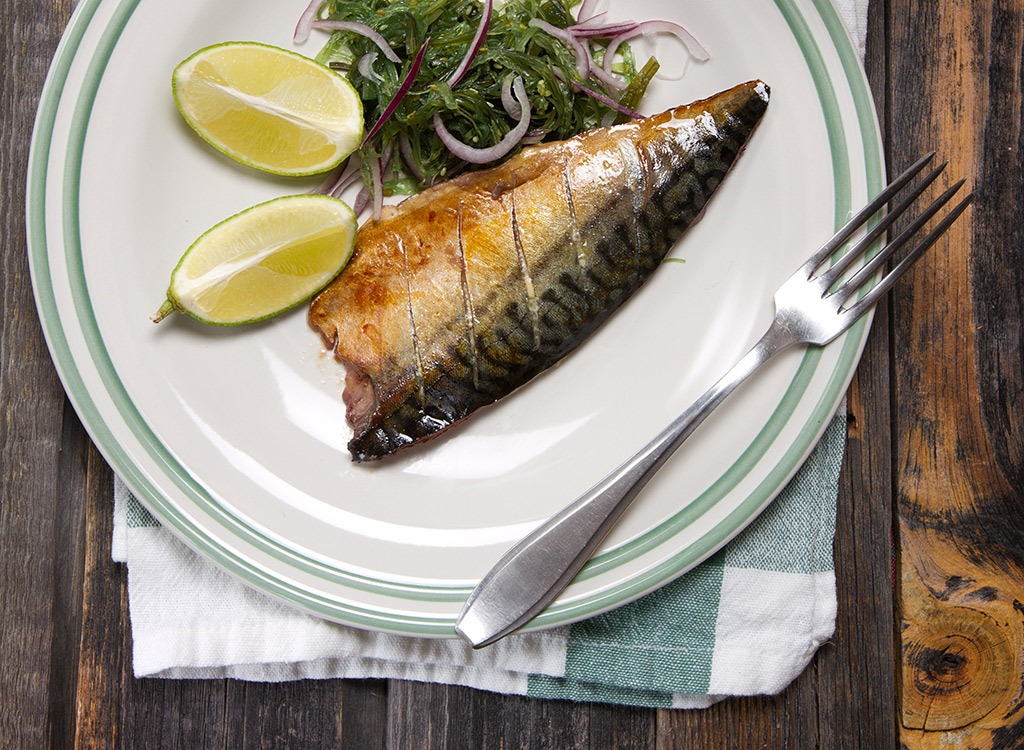

Nutrition (per 3 oz serving): 174 calories, 11.8 g fat (2.8 g saturated fat), 76 mg sodium, 0 g carbs, 0 g fiber, 0 g sugar, 15.8 g protein
Protein (g per 3 oz): 15.8
Omega-3s (mg per 3 oz): 1,954
Mercury levels (parts per billion): 45
Listed on Seafood Watch’s “Super Green List,” this best fish to eat is a triple threat: it’s low in mercury, provides almost eight times the recommended omega-3 intake per day, and is classified as a Seafood Watch “Best Choice” in terms of sustainability. Just watch out for canned mackerel, which can have mercury levels up to 586 ppb.
Read more:
The Best Fast-Food Fish Sandwich, According to a Food Critic
73 Healthy Chicken Recipes for Weight Loss
Source:




